Myanmar
Myanmar (English pronunciation below; Burmese: မြန်မာ, [mjəmà])[nb 1] or Burma (see §Etymology), officially the Republic of the Union of Myanmar[nb 2], is a country in Southeast Asia. Myanmar is bordered by Bangladesh and India to its northwest, China to its northeast, Laos and Thailand to its east and southeast, and the Andaman Sea and the Bay of Bengal to its south and southwest. With a size of 676,578 square kilometres (261,228 square miles), Myanmar is the largest of the Mainland Southeast Asian states by area. As of 2017, the population is about 54 million.[4] Its capital city is Naypyidaw, and its largest city is Yangon (Rangoon).[1] Myanmar has been a member of the Association of Southeast Asian Nations (ASEAN) since 1997.
Republic of the Union of Myanmar
| |
|---|---|
Anthem:
| |
.svg.png) _ASEAN.svg.png) | |
| Capital | Naypyidaw[a] 19°45′N 96°6′E |
| Largest city | Yangon[b] |
| Official languages | Burmese |
| Recognised regional languages | |
| Official script | Burmese script |
| Ethnic groups ([1]) | |
| Religion | Buddhism 87.9% Christianity 6.2% Islam 4.3% Others 1.6%[2] |
| Demonym(s) | Burmese / Myanma[3] |
| Government | Unitary parliamentary constitutional republic |
| Win Myint | |
| Aung San Suu Kyi | |
• 1st Vice President | Myint Swe |
• 2nd Vice President | Henry Van Thio |
| Legislature | Assembly of the Union |
| House of Nationalities | |
| House of Representatives | |
| Formation | |
| c. 180 BCE | |
| 23 December 849 | |
• Taungoo Dynasty | 16 October 1510 |
• Konbaung Dynasty | 29 February 1752 |
| 1 January 1886 | |
| 4 January 1948 | |
| 2 March 1962 | |
• Renamed from "Burma" to "Myanmar" | 18 June 1989 |
| 30 March 2011 | |
| Area | |
• Total | 676,578 km2 (261,228 sq mi) (39th) |
• Water (%) | 3.06 |
| Population | |
• 2017 census | 53,582,855 (2017)[4] (26th) |
• Density | 76/km2 (196.8/sq mi) (125th) |
| GDP (PPP) | 2019 estimate |
• Total | $355 billion[5] (51st) |
• Per capita | $6,707[5] (128th) |
| GDP (nominal) | 2019 estimate |
• Total | $66 billion[5] (72nd) |
• Per capita | $1,245[5] (155th) |
| Gini (2015) | 38.1[6] medium |
| HDI (2018) | medium · 145th |
| Currency | Kyat (K) (MMK) |
| Time zone | UTC+06:30 (MMT) |
| Driving side | right |
| Calling code | +95 |
| ISO 3166 code | MM |
| Internet TLD | .mm |
Early civilisations in Myanmar included the Tibeto-Burman-speaking Pyu city-states in Upper Burma and the Mon kingdoms in Lower Burma.[8] In the 9th century, the Bamar people entered the upper Irrawaddy valley, and following the establishment of the Pagan Kingdom in the 1050s, the Burmese language, culture and Theravada Buddhism slowly became dominant in the country. The Pagan Kingdom fell to Mongol invasions, and several warring states emerged. In the 16th century, reunified by the Taungoo dynasty, the country was for a brief period the largest empire in the history of Mainland Southeast Asia.[9] The early 19th-century Konbaung dynasty ruled over an area that included modern Myanmar and briefly controlled Manipur and Assam as well. The British East India Company seized control of the administration of Myanmar after three Anglo-Burmese Wars in the 19th century, and the country became a British colony. Myanmar was granted independence in 1948 as a democratic nation. Following a coup d'état in 1962, it became a military dictatorship under the Burma Socialist Programme Party.
For most of its independent years, the country has been engrossed in rampant ethnic strife and its myriad ethnic groups have been involved in one of the world's longest-running ongoing civil wars. During this time, the United Nations and several other organisations have reported consistent and systematic human rights violations in the country.[10] In 2011, the military junta was officially dissolved following a 2010 general election, and a nominally civilian government was installed. This, along with the release of Aung San Suu Kyi and political prisoners, has improved the country's human rights record and foreign relations and has led to the easing of trade and other economic sanctions.[11] There is, however, continuing criticism of the government's treatment of ethnic minorities, its response to the ethnic insurgency, and religious clashes.[12] In the landmark 2015 election, Aung San Suu Kyi's party won a majority in both houses. However, the Burmese military remains a powerful force in politics.
Myanmar is a member of the East Asia Summit, Non-Aligned Movement, ASEAN and BIMSTEC, but it is not a member of the Commonwealth of Nations. It is a country rich in jade and gems, oil, natural gas and other mineral resources. Myanmar is also endowed with renewable energy; it has the highest solar power potential compared to other countries of the Great Mekong Subregion.[13] In 2013, its GDP (nominal) stood at US$56.7 billion and its GDP (PPP) at US$221.5 billion.[14] The income gap in Myanmar is among the widest in the world, as a large proportion of the economy is controlled by supporters of the former military government.[15] As of 2016, Myanmar ranks 145 out of 188 countries in human development, according to the Human Development Index.[7]
Etymology
The name of the country has been a matter of dispute and disagreement, particularly in recent decades, focusing mainly on the political legitimacy of those using Myanmar versus Burma.[16][17] Both names derive from the earlier Burmese Myanma or Myamma, an ethnonym for the majority Bamar ethnic group, of uncertain etymology.[18] The terms are also popularly thought to derive from Brahma Desha after Brahma.[19]
In 1989, the military government officially changed the English translations of many names dating back to Burma's colonial period or earlier, including that of the country itself: Burma became Myanmar. The renaming remains a contested issue.[20] Many political and ethnic opposition groups and countries continue to use Burma because they do not recognise the legitimacy of the ruling military government or its authority to rename the country.[21]
In April 2016, soon after taking office, Aung San Suu Kyi said concerning the question of which name should be used that, "it is up to you, because there is nothing in the constitution of our country that says that you must use any term in particular". She continued, "I use Burma very often because I am used to using it. But it does not mean that I require other people to do that as well. And I’ll make an effort to say Myanmar from time to time so you all feel comfortable".[22]
The country's official full name is the "Republic of the Union of Myanmar" (ပြည်ထောင်စုသမ္မတ မြန်မာနိုင်ငံတော်, Pyihtaungsu Thamada Myanma Naingngantaw, pronounced [pjìdàʊɴzṵ θàɴməda̰ mjəmà nàɪɴŋàɴdɔ̀]). Countries that do not officially recognise that name use the long form "Union of Burma" instead.[1][23] In English, the country is popularly known as either Burma or Myanmar. Depending on the register used, the pronunciation would be Bama (pronounced [bəmà]) or Myamah (pronounced [mjəmà]).[20] The name Burma has been in use in English since the 18th century.
Official United States policy retains Burma as the country's name, although the State Department's website lists the country as Burma (Myanmar).[24] The CIA's World Factbook lists the country as Burma as of August 2020.[1] The government of Canada has in the past used Burma,[25] such as in its 2007 legislation imposing sanctions[26] but as of August 2020 generally uses Myanmar.[27] The Czech Republic officially uses Myanmar, although its Ministry of Foreign Affairs uses both Myanmar and Burma on its website.[28] The United Nations uses Myanmar, as do the ASEAN, Australia,[29] Russia, Germany,[30] China, India, Bangladesh, Norway,[31] Japan[25] and Switzerland.[32] Most English-speaking international news media refer to the country by the name Myanmar, including the BBC,[33] CNN,[34] Al Jazeera,[35] Reuters,[36] and the Australian Broadcasting Corporation (ABC)/Radio Australia.[37]
Myanmar is known with a name deriving from Burma as opposed to Myanmar in Spanish, Italian, Romanian, and Greek – Birmania being the local version of Burma in the Spanish language, for example. Myanmar used to be known as Birmânia in Portuguese, and as Birmanie in French.[38] As in the past, French-language media today consistently use Birmanie.[39][40] There is no established pronunciation of the name Myanmar in English. It is approximated at least nine different ways: /ˌmjænˈmɑːr/, /ˈmiːənmɑːr/, /ˌmjɑːnˈmɑːr/ (![]()
History
Prehistory

Archaeological evidence shows that Homo erectus lived in the region now known as Myanmar as early as 750,000 years ago, with no more erectus finds after 75,000 years ago.[42] The first evidence of Homo sapiens is dated to about 25,000 BP with discoveries of stone tools in central Myanmar.[43] Evidence of Neolithic age domestication of plants and animals and the use of polished stone tools dating to sometime between 10,000 and 6,000 BCE has been discovered in the form of cave paintings in Padah-Lin Caves.[44]
The Bronze Age arrived c. 1500 BCE when people in the region were turning copper into bronze, growing rice and domesticating poultry and pigs; they were among the first people in the world to do so.[45] Human remains and artefacts from this era were discovered in Monywa District in the Sagaing Region.[46] The Iron Age began around 500 BCE with the emergence of iron-working settlements in an area south of present-day Mandalay.[47] Evidence also shows the presence of rice-growing settlements of large villages and small towns that traded with their surroundings as far as China between 500 BCE and 200 CE.[48] Iron Age Burmese cultures also had influences from outside sources such as India and Thailand, as seen in their funerary practices concerning child burials. This indicates some form of communication between groups in Myanmar and other places, possibly through trade.[49]
Early city-states
Around the second century BCE the first-known city-states emerged in central Myanmar. The city-states were founded as part of the southward migration by the Tibeto-Burman-speaking Pyu people, the earliest inhabitants of Myanmar of whom records are extant, from present-day Yunnan.[50] The Pyu culture was heavily influenced by trade with India, importing Buddhism as well as other cultural, architectural and political concepts, which would have an enduring influence on later Burmese culture and political organisation.[51]
By the 9th century, several city-states had sprouted across the land: the Pyu in the central dry zone, Mon along the southern coastline and Arakanese along the western littoral. The balance was upset when the Pyu came under repeated attacks from Nanzhao between the 750s and the 830s. In the mid-to-late 9th century the Bamar people founded a small settlement at Bagan. It was one of several competing city-states until the late 10th century when it grew in authority and grandeur.[52]
Imperial Burma
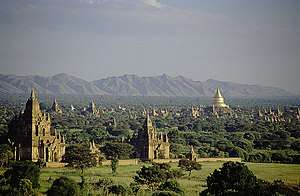
Pagan gradually grew to absorb its surrounding states until the 1050s–1060s when Anawrahta founded the Pagan Kingdom, the first ever unification of the Irrawaddy valley and its periphery. In the 12th and 13th centuries, the Pagan Empire and the Khmer Empire were two main powers in mainland Southeast Asia.[53] The Burmese language and culture gradually became dominant in the upper Irrawaddy valley, eclipsing the Pyu, Mon and Pali norms by the late 12th century.[54] Theravada Buddhism slowly began to spread to the village level, although Tantric, Mahayana, Hinduism, and folk religion remained heavily entrenched. Pagan's rulers and wealthy built over 10,000 Buddhist temples in the Pagan capital zone alone. Repeated Mongol invasions in the late 13th century toppled the four-century-old kingdom in 1287.[54]
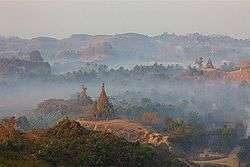
Pagan's collapse was followed by 250 years of political fragmentation that lasted well into the 16th century. Like the Burmans four centuries earlier, Shan migrants who arrived with the Mongol invasions stayed behind. Several competing Shan States came to dominate the entire northwestern to eastern arc surrounding the Irrawaddy valley. The valley too was beset with petty states until the late 14th century when two sizeable powers, Ava Kingdom and Hanthawaddy Kingdom, emerged. In the west, a politically fragmented Arakan was under competing influences of its stronger neighbours until the Kingdom of Mrauk U unified the Arakan coastline for the first time in 1437. The kingdom was a protectorate of the Bengal Sultanate at different time periods.[55]
In the 14th and 15th centuries, Ava fought wars of unification but could never quite reassemble the lost empire. Having held off Ava, the Mon-speaking Hanthawaddy entered its golden age, and Arakan went on to become a power in its own right for the next 350 years. In contrast, constant warfare left Ava greatly weakened, and it slowly disintegrated from 1481 onward. In 1527, the Confederation of Shan States conquered Ava and ruled Upper Myanmar until 1555.
Like the Pagan Empire, Ava, Hanthawaddy and the Shan states were all multi-ethnic polities. Despite the wars, cultural synchronisation continued. This period is considered a golden age for Burmese culture. Burmese literature "grew more confident, popular, and stylistically diverse", and the second generation of Burmese law codes as well as the earliest pan-Burma chronicles emerged.[56] Hanthawaddy monarchs introduced religious reforms that later spread to the rest of the country.[57] Many splendid temples of Mrauk U were built during this period.
Taungoo and colonialism
.png)
Political unification returned in the mid-16th century, through the efforts of Taungoo, a former vassal state of Ava. Taungoo's young, ambitious King Tabinshwehti defeated the more powerful Hanthawaddy in the Toungoo–Hanthawaddy War. His successor Bayinnaung went on to conquer a vast swath of mainland Southeast Asia including the Shan states, Lan Na, Manipur, Mong Mao, the Ayutthaya Kingdom, Lan Xang and southern Arakan. However, the largest empire in the history of Southeast Asia unravelled soon after Bayinnaung's death in 1581, completely collapsing by 1599. Ayutthaya seized Tenasserim and Lan Na, and Portuguese mercenaries established Portuguese rule at Thanlyin (Syriam).
The dynasty regrouped and defeated the Portuguese in 1613 and Siam in 1614. It restored a smaller, more manageable kingdom, encompassing Lower Myanmar, Upper Myanmar, Shan states, Lan Na and upper Tenasserim. The restored Toungoo kings created a legal and political framework whose basic features continued well into the 19th century. The crown completely replaced the hereditary chieftainships with appointed governorships in the entire Irrawaddy valley and greatly reduced the hereditary rights of Shan chiefs. Its trade and secular administrative reforms built a prosperous economy for more than 80 years. From the 1720s onward, the kingdom was beset with repeated Meithei raids into Upper Myanmar and a nagging rebellion in Lan Na. In 1740, the Mon of Lower Myanmar founded the Restored Hanthawaddy Kingdom. Hanthawaddy forces sacked Ava in 1752, ending the 266-year-old Toungoo Dynasty.
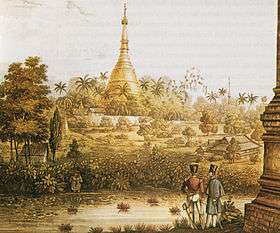
After the fall of Ava, the Konbaung–Hanthawaddy War involved one resistance group under Alaungpaya defeating the Restored Hanthawaddy, and by 1759 he had reunited all of Myanmar and Manipur and driven out the French and the British, who had provided arms to Hanthawaddy. By 1770, Alaungpaya's heirs had subdued much of Laos and fought and won the Burmese–Siamese War against Ayutthaya and the Sino-Burmese War against Qing China.[58]
With Burma preoccupied by the Chinese threat, Ayutthaya recovered its territories by 1770 and went on to capture Lan Na by 1776. Burma and Siam went to war until 1855, but all resulted in a stalemate, exchanging Tenasserim (to Burma) and Lan Na (to Ayutthaya). Faced with a powerful China and a resurgent Ayutthaya in the east, King Bodawpaya turned west, acquiring Arakan (1785), Manipur (1814) and Assam (1817). It was the second-largest empire in Burmese history but also one with a long ill-defined border with British India.[59]
The breadth of this empire was short lived. In 1826, Burma lost Arakan, Manipur, Assam and Tenasserim to the British in the First Anglo-Burmese War. In 1852, the British easily seized Lower Burma in the Second Anglo-Burmese War. King Mindon Min tried to modernise the kingdom and in 1875 narrowly avoided annexation by ceding the Karenni States. The British, alarmed by the consolidation of French Indochina, annexed the remainder of the country in the Third Anglo-Burmese War in 1885.
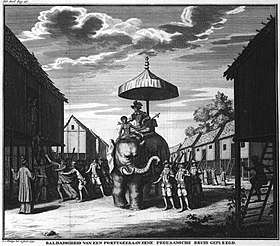
Konbaung kings extended Restored Toungoo's administrative reforms and achieved unprecedented levels of internal control and external expansion. For the first time in history, the Burmese language and culture came to predominate the entire Irrawaddy valley. The evolution and growth of Burmese literature and theatre continued, aided by an extremely high adult male literacy rate for the era (half of all males and 5% of females).[60] Nonetheless, the extent and pace of reforms were uneven and ultimately proved insufficient to stem the advance of British colonialism.
British Burma (1824–1948)
Burma in British India
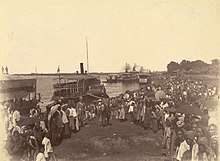
In the 18th century Burmese rulers, whose country had not previously been of particular interest to European traders, sought to maintain their traditional influence in the western areas of Assam, Manipur and Arakan. Pressing them, however, was the British East India Company, which was expanding its interests eastwards over the same territory. Over the next sixty years, diplomacy, raids, treaties and compromises, known collectively as the Anglo-Burmese Wars, continued until Britain proclaimed control over most of Burma.[61] With the fall of Mandalay, all of Burma came under British rule, being annexed on 1 January 1886.
Throughout the colonial era, many Indians arrived as soldiers, civil servants, construction workers and traders and, along with the Anglo-Burmese community, dominated commercial and civil life in Burma. Rangoon became the capital of British Burma and an important port between Calcutta and Singapore. Burmese resentment was strong and was vented in violent riots that paralysed Rangoon on occasion all the way until the 1930s.[62] Some of the discontent was caused by a disrespect for Burmese culture and traditions such as the British refusal to remove shoes when they entered pagodas. Buddhist monks became the vanguards of the independence movement. U Wisara, an activist monk, died in prison after a 166-day hunger strike to protest against a rule that forbade him to wear his Buddhist robes while imprisoned.[63]
Separation of British Burma from British India
On 1 April 1937, Burma became a separately administered colony of Great Britain, and Ba Maw became the first Prime Minister and Premier of Burma. Ba Maw was an outspoken advocate for Burmese self-rule, and he opposed the participation of Great Britain, and by extension Burma, in World War II. He resigned from the Legislative Assembly and was arrested for sedition. In 1940, before Japan formally entered the war, Aung San formed the Burma Independence Army in Japan.
As a major battleground, Burma was devastated during World War II by the Japanese invasion. Within months after they entered the war, Japanese troops had advanced on Rangoon, and the British administration had collapsed. A Burmese Executive Administration headed by Ba Maw was established by the Japanese in August 1942. Wingate's British Chindits were formed into long-range penetration groups trained to operate deep behind Japanese lines.[64] A similar American unit, Merrill's Marauders, followed the Chindits into the Burmese jungle in 1943.[65] Beginning in late 1944, allied troops launched a series of offensives that led to the end of Japanese rule in July 1945. The battles were intense with much of Burma laid waste by the fighting. Overall, the Japanese lost some 150,000 men in Burma with 1,700 prisoners taken.[66] Although many Burmese fought initially for the Japanese as part of the Burma Independence Army, many Burmese, mostly from the ethnic minorities, served in the British Burma Army.[67] The Burma National Army and the Arakan National Army fought with the Japanese from 1942 to 1944 but switched allegiance to the Allied side in 1945. Under Japanese occupation, 170,000 to 250,000 civilians died.[68]
Following World War II, Aung San negotiated the Panglong Agreement with ethnic leaders that guaranteed the independence of Myanmar as a unified state. Aung Zan Wai, Pe Khin, Bo Hmu Aung, Sir Maung Gyi, Dr. Sein Mya Maung, Myoma U Than Kywe were among the negotiators of the historical Panglong Conference negotiated with Bamar leader General Aung San and other ethnic leaders in 1947. In 1947, Aung San became Deputy Chairman of the Executive Council of Myanmar, a transitional government. But in July 1947, political rivals[69] assassinated Aung San and several cabinet members.[70]
Independence (1948–1962)
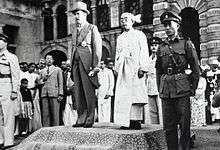
On 4 January 1948, the nation became an independent republic, under the terms of the Burma Independence Act 1947. The new country was named the Union of Burma, with Sao Shwe Thaik as its first president and U Nu as its first prime minister. Unlike most other former British colonies and overseas territories, Burma did not become a member of the Commonwealth. A bicameral parliament was formed, consisting of a Chamber of Deputies and a Chamber of Nationalities,[71] and multi-party elections were held in 1951–1952, 1956 and 1960.
The geographical area Burma encompasses today can be traced to the Panglong Agreement, which combined Burma Proper, which consisted of Lower Burma and Upper Burma, and the Frontier Areas, which had been administered separately by the British.[72]
In 1961, U Thant, the Union of Burma's Permanent Representative to the United Nations and former secretary to the prime minister, was elected Secretary-General of the United Nations, a position he held for ten years.[73] Among the Burmese to work at the UN when he was secretary-general was Aung San Suu Kyi (daughter of Aung San), who went on to become winner of the 1991 Nobel Peace Prize.
When the non-Burman ethnic groups pushed for autonomy or federalism, alongside having a weak civilian government at the centre, the military leadership staged a coup d’état in 1962. Though incorporated in the 1947 Constitution, successive military governments construed the use of the term ‘federalism’ as being anti-national, anti-unity and pro-disintegration.[74]
Military rule (1962–2011)
On 2 March 1962, the military led by General Ne Win took control of Burma through a coup d'état, and the government has been under direct or indirect control by the military since then. Between 1962 and 1974, Myanmar was ruled by a revolutionary council headed by the general. Almost all aspects of society (business, media, production) were nationalised or brought under government control under the Burmese Way to Socialism,[75] which combined Soviet-style nationalisation and central planning.
A new constitution of the Socialist Republic of the Union of Burma was adopted in 1974. Until 1988, the country was ruled as a one-party system, with the general and other military officers resigning and ruling through the Burma Socialist Programme Party (BSPP).[76] During this period, Myanmar became one of the world's most impoverished countries.[77] There were sporadic protests against military rule during the Ne Win years, and these were almost always violently suppressed. On 7 July 1962, the government broke up demonstrations at Rangoon University, killing 15 students.[75] In 1974, the military violently suppressed anti-government protests at the funeral of U Thant. Student protests in 1975, 1976, and 1977 were quickly suppressed by overwhelming force.[76]
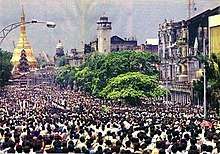
In 1988, unrest over economic mismanagement and political oppression by the government led to widespread pro-democracy demonstrations throughout the country known as the 8888 Uprising. Security forces killed thousands of demonstrators, and General Saw Maung staged a coup d'état and formed the State Law and Order Restoration Council (SLORC). In 1989, SLORC declared martial law after widespread protests. The military government finalised plans for People's Assembly elections on 31 May 1989.[78] SLORC changed the country's official English name from the "Socialist Republic of the Union of Burma" to the "Union of Myanmar" in 18 June 1989 by enacting the adaptation of the expression law.
In May 1990, the government held free elections for the first time in almost 30 years, and the National League for Democracy (NLD), the party of Aung San Suu Kyi, won 392 out of a total 492 seats (i.e., 80% of the seats). However, the military junta refused to cede power[79] and continued to rule the nation as SLORC until 1997, and then as the State Peace and Development Council (SPDC) until its dissolution in March 2011. On 23 June 1997, Myanmar was admitted into the Association of Southeast Asian Nations. On 27 March 2006, the military junta, which had moved the national capital from Yangon to a site near Pyinmana in November 2005, officially named the new capital Naypyidaw, meaning "city of the kings".[80]
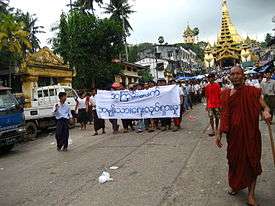
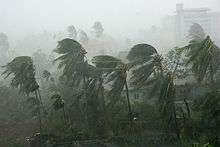
In August 2007, an increase in the price of fuel led to the Saffron Revolution led by Buddhist monks that were dealt with harshly by the government.[81] The government cracked down on them on 26 September 2007, with reports of barricades at the Shwedagon Pagoda and monks killed. There were also rumours of disagreement within the Burmese armed forces, but none was confirmed. The military crackdown against unarmed protesters was widely condemned as part of the international reactions to the Saffron Revolution and led to an increase in economic sanctions against the Burmese Government.
In May 2008, Cyclone Nargis caused extensive damage in the densely populated rice-farming delta of the Irrawaddy Division.[82] It was the worst natural disaster in Burmese history with reports of an estimated 200,000 people dead or missing, damages totalled to 10 billion US dollars, and as many as 1 million were left homeless.[83] In the critical days following this disaster, Myanmar's isolationist government was accused of hindering United Nations recovery efforts.[84] Humanitarian aid was requested, but concerns about foreign military or intelligence presence in the country delayed the entry of United States military planes delivering medicine, food, and other supplies.[85]
In early August 2009, a conflict broke out in Shan State in northern Myanmar. For several weeks, junta troops fought against ethnic minorities including the Han Chinese,[86] Wa, and Kachin.[87][88] During 8–12 August, the first days of the conflict, as many as 10,000 Burmese civilians fled to Yunnan in neighbouring China.[87][88][89]
Civil wars
Civil wars have been a constant feature of Myanmar's socio-political landscape since the attainment of independence in 1948. These wars are predominantly struggles for ethnic and sub-national autonomy, with the areas surrounding the ethnically Bamar central districts of the country serving as the primary geographical setting of conflict. Foreign journalists and visitors require a special travel permit to visit the areas in which Myanmar's civil wars continue.[90]
In October 2012, the ongoing conflicts in Myanmar included the Kachin conflict,[91] between the Pro-Christian Kachin Independence Army and the government;[92] a civil war between the Rohingya Muslims and the government and non-government groups in Rakhine State;[93] and a conflict between the Shan,[94] Lahu, and Karen[95][96] minority groups, and the government in the eastern half of the country. In addition, al-Qaeda signalled an intention to become involved in Myanmar. In a video released on 3 September 2014, mainly addressed to India, the militant group's leader Ayman al-Zawahiri said al-Qaeda had not forgotten the Muslims of Myanmar and that the group was doing "what they can to rescue you".[97] In response, the military raised its level of alertness, while the Burmese Muslim Association issued a statement saying Muslims would not tolerate any threat to their motherland.[98]
Armed conflict between ethnic Chinese rebels and the Myanmar Armed Forces resulted in the Kokang offensive in February 2015. The conflict had forced 40,000 to 50,000 civilians to flee their homes and seek shelter on the Chinese side of the border.[99] During the incident, the government of China was accused of giving military assistance to the ethnic Chinese rebels. Burmese officials have been historically "manipulated" and pressured by the Chinese government throughout Burmese modern history to create closer and binding ties with China, creating a Chinese satellite state in Southeast Asia.[100] However, uncertainties exist as clashes between Burmese troops and local insurgent groups continue.
Democratic reforms
The goal of the Burmese constitutional referendum of 2008, held on 10 May 2008, is the creation of a "discipline-flourishing democracy". As part of the referendum process, the name of the country was changed from the "Union of Myanmar" to the "Republic of the Union of Myanmar", and general elections were held under the new constitution in 2010. Observer accounts of the 2010 election describe the event as mostly peaceful; however, allegations of polling station irregularities were raised, and the United Nations (UN) and a number of Western countries condemned the elections as fraudulent.[101]

The military-backed Union Solidarity and Development Party declared victory in the 2010 elections, stating that it had been favoured by 80 per cent of the votes; however, the claim was disputed by numerous pro-democracy opposition groups who asserted that the military regime had engaged in rampant fraud.[102][103] One report documented 77 per cent as the official turnout rate of the election.[102] The military junta was dissolved on 30 March 2011.
Opinions differ whether the transition to liberal democracy is underway. According to some reports, the military's presence continues as the label "disciplined democracy" suggests. This label asserts that the Burmese military is allowing certain civil liberties while clandestinely institutionalising itself further into Burmese politics. Such an assertion assumes that reforms only occurred when the military was able to safeguard its own interests through the transition—here, "transition" does not refer to a transition to a liberal democracy but transition to a quasi-military rule.[104]
Since the 2010 election, the government has embarked on a series of reforms to direct the country towards liberal democracy, a mixed economy, and reconciliation, although doubts persist about the motives that underpin such reforms. The series of reforms includes the release of pro-democracy leader Aung San Suu Kyi from house arrest, the establishment of the National Human Rights Commission, the granting of general amnesties for more than 200 political prisoners, new labour laws that permit labour unions and strikes, a relaxation of press censorship, and the regulation of currency practices.[105]
The impact of the post-election reforms has been observed in numerous areas, including ASEAN's approval of Myanmar's bid for the position of ASEAN chair in 2014;[106] the visit by United States Secretary of State Hillary Clinton in December 2011 for the encouragement of further progress, which was the first visit by a secretary of state in more than fifty years,[107] during which President Bill Clinton met with the Burmese president and former military commander Thein Sein, as well as opposition leader Aung San Suu Kyi;[108] and the participation of Aung San Suu Kyi's NLD party in the 2012 by-elections, facilitated by the government's abolition of the laws that previously barred the NLD.[109] In the April 2012 by-elections, the NLD won 43 of the 45 available seats; previously an illegal organisation, the NLD had not won a single seat under the new constitution. The 2012 by-elections were also the first time that international representatives were allowed to monitor the voting process in Myanmar.[110]
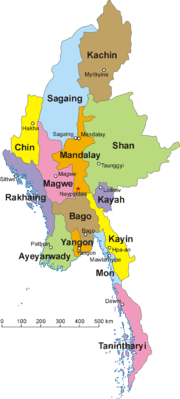
Aung San Suu Kyi era (2016-present)
General elections were held on 8 November 2015. These were the first openly contested elections held in Myanmar since 1990. The results gave the NLD an absolute majority of seats in both chambers of the national parliament, enough to ensure that its candidate would become president, while NLD leader Aung San Suu Kyi is constitutionally barred from the presidency.[111] The new parliament convened on 1 February 2016,[112] and on 15 March 2016, Htin Kyaw was elected as the first non-military president since the military coup of 1962.[113] On 6 April 2016, Aung San Suu Kyi assumed the newly created role of state counsellor, a role akin to a prime minister. Sinec then Aung San Suu Kyi is the de facto leader of Myanmar.
Geography
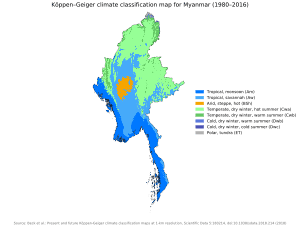
Myanmar has a total area of 678,500 square kilometres (262,000 sq mi). It lies between latitudes 9° and 29°N, and longitudes 92° and 102°E. Myanmar is bordered in the northwest by the Chittagong Division of Bangladesh and the Mizoram, Manipur, Nagaland and Arunachal Pradesh states of India. Its north and northeast border is with the Tibet Autonomous Region and Yunnan for a Sino-Myanmar border total of 2,185 km (1,358 mi). It is bounded by Laos and Thailand to the southeast. Myanmar has 1,930 km (1,200 mi) of contiguous coastline along the Bay of Bengal and Andaman Sea to the southwest and the south, which forms one quarter of its total perimeter.[1]
In the north, the Hengduan Mountains form the border with China. Hkakabo Razi, located in Kachin State, at an elevation of 5,881 metres (19,295 ft), is the highest point in Myanmar.[114] Many mountain ranges, such as the Rakhine Yoma, the Bago Yoma, the Shan Hills and the Tenasserim Hills exist within Myanmar, all of which run north-to-south from the Himalayas.[115] The mountain chains divide Myanmar's three river systems, which are the Irrawaddy, Salween (Thanlwin), and the Sittaung rivers.[116] The Irrawaddy River, Myanmar's longest river at nearly 2,170 kilometres (1,348 mi), flows into the Gulf of Martaban. Fertile plains exist in the valleys between the mountain chains.[115] The majority of Myanmar's population lives in the Irrawaddy valley, which is situated between the Rakhine Yoma and the Shan Plateau.
Administrative divisions
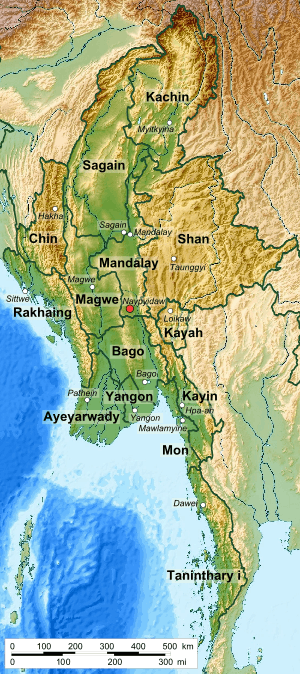

Myanmar is divided into seven states (ပြည်နယ်) and seven regions (တိုင်းဒေသကြီး), formerly called divisions.[117] Regions are predominantly Bamar (that is, mainly inhabited by the dominant ethnic group). States, in essence, are regions that are home to particular ethnic minorities. The administrative divisions are further subdivided into districts, which are further subdivided into townships, wards, and villages.
Below are the number of districts, townships, cities/towns, wards, village groups and villages in each division and state of Myanmar as of 31 December 2001:[118]
| No. | State/Region | Districts | Town ships |
Cities/ Towns |
Wards | Village groups |
Villages |
|---|---|---|---|---|---|---|---|
| 1 | Kachin State | 4 | 18 | 20 | 116 | 606 | 2630 |
| 2 | Kayah State | 2 | 7 | 7 | 29 | 79 | 624 |
| 3 | Kayin State | 3 | 7 | 10 | 46 | 376 | 2092 |
| 4 | Chin State | 2 | 9 | 9 | 29 | 475 | 1355 |
| 5 | Sagaing Region | 8 | 37 | 37 | 171 | 1769 | 6095 |
| 6 | Tanintharyi Region | 3 | 10 | 10 | 63 | 265 | 1255 |
| 7 | Bago Region | 4 | 28 | 33 | 246 | 1424 | 6498 |
| 8 | Magway Region | 5 | 25 | 26 | 160 | 1543 | 4774 |
| 9 | Mandalay Region | 7 | 31 | 29 | 259 | 1611 | 5472 |
| 10 | Mon State | 2 | 10 | 11 | 69 | 381 | 1199 |
| 11 | Rakhine State | 4 | 17 | 17 | 120 | 1041 | 3871 |
| 12 | Yangon Region | 4 | 45 | 20 | 685 | 634 | 2119 |
| 13 | Shan State | 11 | 54 | 54 | 336 | 1626 | 15513 |
| 14 | Ayeyarwady Region | 6 | 26 | 29 | 219 | 1912 | 11651 |
| Total | 63 | 324 | 312 | 2548 | 13742 | 65148 |
Climate
Much of the country lies between the Tropic of Cancer and the Equator. It lies in the monsoon region of Asia, with its coastal regions receiving over 5,000 mm (196.9 in) of rain annually. Annual rainfall in the delta region is approximately 2,500 mm (98.4 in), while average annual rainfall in the dry zone in central Myanmar is less than 1,000 mm (39.4 in). The northern regions of Myanmar are the coolest, with average temperatures of 21 °C (70 °F). Coastal and delta regions have an average maximum temperature of 32 °C (89.6 °F).[116]
Environment
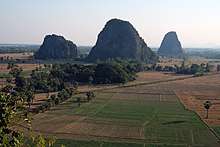
Myanmar continues to perform badly in the global Environmental Performance Index (EPI) with an overall ranking of 153 out of 180 countries in 2016; among the worst in the South Asian region, only ahead of Bangladesh and Afghanistan. The EPI was established in 2001 by the World Economic Forum as a global gauge to measure how well individual countries perform in implementing the United Nations' Sustainable Development Goals. The environmental areas where Myanmar performs worst (ie. highest ranking) are air quality (174), health impacts of environmental issues (143) and biodiversity and habitat (142). Myanmar performs best (ie. lowest ranking) in environmental impacts of fisheries (21) but with declining fish stocks. Despite several issues, Myanmar also ranks 64 and scores very good (ie. a high percentage of 93.73%) in environmental effects of the agricultural industry because of an excellent management of the nitrogen cycle.[119][120] Myanmar is one of the most highly vulnerable countries to climate change; this poses a number of social, political, economic and foreign policy challenges to the country.[121]
Flora and fauna
Myanmar's slow economic growth has contributed to the preservation of much of its environment and ecosystems. Forests, including dense tropical growth and valuable teak in lower Myanmar, cover over 49% of the country, including areas of acacia, bamboo, ironwood and Magnolia champaca. Coconut and betel palm and rubber have been introduced. In the highlands of the north, oak, pine and various rhododendrons cover much of the land.[122]
Heavy logging since the new 1995 forestry law went into effect has seriously reduced forest acreage and wildlife habitat.[123] The lands along the coast support all varieties of tropical fruits and once had large areas of mangroves although much of the protective mangroves have disappeared. In much of central Myanmar (the dry zone), vegetation is sparse and stunted.
Typical jungle animals, particularly tigers, occur sparsely in Myanmar. In upper Myanmar, there are rhinoceros, wild water buffalo, clouded leopard, wild boars, deer, antelope, and elephants, which are also tamed or bred in captivity for use as work animals, particularly in the lumber industry. Smaller mammals are also numerous, ranging from gibbons and monkeys to flying foxes. The abundance of birds is notable with over 800 species, including parrots, myna, peafowl, red junglefowl, weaverbirds, crows, herons, and barn owl. Among reptile species there are crocodiles, geckos, cobras, Burmese pythons, and turtles. Hundreds of species of freshwater fish are wide-ranging, plentiful and are very important food sources.[124]
Government and politics

The constitution of Myanmar, its third since independence, was drafted by its military rulers and published in September 2008. The country is governed as a parliamentary system with a bicameral legislature (with an executive president accountable to the legislature), with 25% of the legislators appointed by the military and the rest elected in general elections.
The legislature, called the Assembly of the Union, is bicameral and made up of two houses: the 224-seat upper House of Nationalities and the 440-seat lower House of Representatives. The upper house consists 168 members who are directly elected and 56 who are appointed by the Burmese Armed Forces. The lower house consists of 330 members who are directly elected and 110 who are appointed by the armed forces.
Political culture
The major political parties are the National League for Democracy and the Union Solidarity and Development Party.
Myanmar's army-drafted constitution was approved in a referendum in May 2008. The results, 92.4% of the 22 million voters with an official turnout of 99%, are considered suspect by many international observers and by the National League of Democracy with reports of widespread fraud, ballot stuffing, and voter intimidation.[125]
The elections of 2010 resulted in a victory for the military-backed Union Solidarity and Development Party. Various foreign observers questioned the fairness of the elections.[126][127][128] One criticism of the election was that only government-sanctioned political parties were allowed to contest in it and the popular National League for Democracy was declared illegal.[129] However, immediately following the elections, the government ended the house arrest of the democracy advocate and leader of the National League for Democracy, Aung San Suu Kyi,[130] and her ability to move freely around the country is considered an important test of the military's movement toward more openness.[129] After unexpected reforms in 2011, NLD senior leaders have decided to register as a political party and to field candidates in future by-elections.[131]
Myanmar's recent political history is underlined by its struggle to establish democratic structures amidst conflicting factions. This political transition from a closely held military rule to a free democratic system is widely believed to be determining the future of Myanmar. The resounding victory of Aung San Suu Kyi's National League for Democracy in 2015 general elections has raised hope for a successful culmination of this transition.[132][133]
Myanmar rates as a corrupt nation on the Corruption Perceptions Index with a rank of 130th out of 180 countries worldwide, with 1st being least corrupt, as of 2019.[134]
Foreign relations
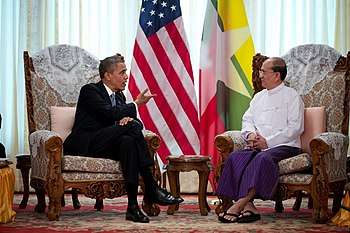
Though the country's foreign relations, particularly with Western nations, have historically been strained, the situation has markedly improved since the reforms following the 2010 elections. After years of diplomatic isolation and economic and military sanctions,[135] the United States relaxed curbs on foreign aid to Myanmar in November 2011[108] and announced the resumption of diplomatic relations on 13 January 2012[136] The European Union has placed sanctions on Myanmar, including an arms embargo, cessation of trade preferences, and suspension of all aid with the exception of humanitarian aid.[137]
.jpg)
Sanctions imposed by the United States and European countries against the former military government, coupled with boycotts and other direct pressure on corporations by supporters of the democracy movement, have resulted in the withdrawal from the country of most U.S. and many European companies.[138] On 13 April 2012 British Prime Minister David Cameron called for the economic sanctions on Myanmar to be suspended in the wake of the pro-democracy party gaining 43 seats out of a possible 45 in the 2012 by-elections with the party leader, Aung San Suu Kyi becoming a member of the Burmese parliament.[139]
Despite Western isolation, Asian corporations have generally remained willing to continue investing in the country and to initiate new investments, particularly in natural resource extraction. The country has close relations with neighbouring India and China with several Indian and Chinese companies operating in the country. Under India's Look East policy, fields of co-operation between India and Myanmar include remote sensing,[140] oil and gas exploration,[141] information technology,[142] hydropower[143] and construction of ports and buildings.[144]
In 2008, India suspended military aid to Myanmar over the issue of human rights abuses by the ruling junta, although it has preserved extensive commercial ties, which provide the regime with much-needed revenue.[145] The thaw in relations began on 28 November 2011, when Belarusian Prime Minister Mikhail Myasnikovich and his wife Ludmila arrived in the capital, Naypyidaw, the same day as the country received a visit by U.S. Secretary of State Hillary Clinton, who also met with pro-democracy opposition leader Aung San Suu Kyi.[146] International relations progress indicators continued in September 2012 when Aung San Suu Kyi visited the United States[147] followed by Myanmar's reformist president visit to the United Nations.[148]
In May 2013, Thein Sein became the first Myanmar president to visit the White House in 47 years; the last Burmese leader to visit the White House was Ne Win in September 1966. President Barack Obama praised the former general for political and economic reforms and the cessation of tensions between Myanmar and the United States. Political activists objected to the visit because of concerns over human rights abuses in Myanmar, but Obama assured Thein Sein that Myanmar will receive U.S. support. The two leaders discussed to release more political prisoners, the institutionalisation of political reform and rule of law, and ending ethnic conflict in Myanmar—the two governments agreed to sign a bilateral trade and investment framework agreement on 21 May 2013.[149]
In June 2013, Myanmar held its first ever summit, the World Economic Forum on East Asia 2013. A regional spinoff of the annual World Economic Forum in Davos, Switzerland, the summit was held on 5–7 June and attended by 1,200 participants, including 10 heads of state, 12 ministers and 40 senior directors from around the world.[150] In July 2019, UN ambassadors of 37 countries, including Myanmar, have signed a joint letter to the United Nations Human Rights Council defending China's treatment of Uyghurs and other Muslim minority groups in the Xinjiang region.[151]
Military
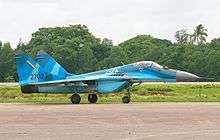
Myanmar has received extensive military aid from China in the past.[152] Myanmar has been a member of ASEAN since 1997. Though it gave up its turn to hold the ASEAN chair and host the ASEAN Summit in 2006, it chaired the forum and hosted the summit in 2014.[153] In November 2008, Myanmar's political situation with neighbouring Bangladesh became tense as they began searching for natural gas in a disputed block of the Bay of Bengal.[154] Controversy surrounding the Rohingya population also remains an issue between Bangladesh and Myanmar.[155]
Myanmar's armed forces are known as the Tatmadaw, which numbers 488,000. The Tatmadaw comprises the Army, the Navy, and the Air Force. The country ranked twelfth in the world for its number of active troops in service.[23] The military is very influential in Myanmar, with all top cabinet and ministry posts usually held by military officials. Official figures for military spending are not available. Estimates vary widely because of uncertain exchange rates, but Myanmar's military forces' expenses are high.[156] Myanmar imports most of its weapons from Russia, Ukraine, China and India.
Myanmar is building a research nuclear reactor near Pyin Oo Lwin with help from Russia. It is one of the signatories of the nuclear non-proliferation pact since 1992 and a member of the International Atomic Energy Agency (IAEA) since 1957. The military junta had informed the IAEA in September 2000 of its intention to construct the reactor.[157][158] In 2010 as part of the Wikileaks leaked cables, Myanmar was suspected of using North Korean construction teams to build a fortified surface-to-air missile facility.[159]
Until 2005, the United Nations General Assembly annually adopted a detailed resolution about the situation in Myanmar by consensus.[160][161][162][163] But in 2006 a divided United Nations General Assembly voted through a resolution that strongly called upon the government of Myanmar to end its systematic violations of human rights.[164] In January 2007, Russia and China vetoed a draft resolution before the United Nations Security Council[165] calling on the government of Myanmar to respect human rights and begin a democratic transition. South Africa also voted against the resolution.[166]
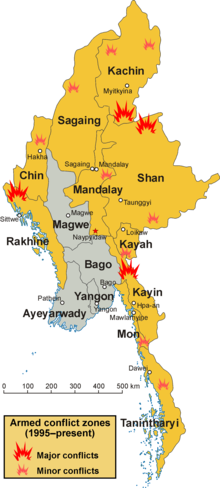
Human rights and internal conflicts
There is consensus that the former military regime in Myanmar (1962–2010) was one of the world's most repressive and abusive regimes.[167][168] In November 2012, Samantha Power, Barack Obama's Special Assistant to the President on Human Rights, wrote on the White House blog in advance of the president's visit that "Serious human rights abuses against civilians in several regions continue, including against women and children."[94] Members of the United Nations and major international human rights organisations have issued repeated and consistent reports of widespread and systematic human rights violations in Myanmar. The United Nations General Assembly has repeatedly[169] called on the Burmese military junta to respect human rights and in November 2009 the General Assembly adopted a resolution "strongly condemning the ongoing systematic violations of human rights and fundamental freedoms" and calling on the Burmese military regime "to take urgent measures to put an end to violations of international human rights and humanitarian law."[170]
International human rights organisations including Human Rights Watch,[171] Amnesty International[172] and the American Association for the Advancement of Science[173] have repeatedly documented and condemned widespread human rights violations in Myanmar. The Freedom in the World 2011 report by Freedom House notes, "The military junta has ... suppressed nearly all basic rights; and committed human rights abuses with impunity." In July 2013, the Assistance Association for Political Prisoners indicated that there were approximately 100 political prisoners being held in Burmese prisons.[174][175][176][177] Evidence gathered by a British researcher was published in 2005 regarding the extermination or "Burmisation" of certain ethnic minorities, such as the Karen, Karenni and Shan.[178]
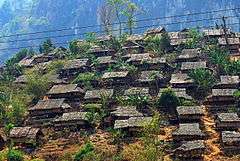
Child soldiers
Child soldiers had played a major part in the Burmese Army until around 2012. The Independent reported in June 2012 that "Children are being sold as conscripts into the Burmese military for as little as $40 and a bag of rice or a can of petrol."[180] The UN's Special Representative of the Secretary-General for Children and Armed Conflict, Radhika Coomaraswamy, who stepped down from her position a week later, met representatives of the government of Myanmar in July 2012 and stated that she hoped the government's signing of an action plan would "signal a transformation."[181] In September 2012, the Myanmar Armed Forces released 42 child soldiers, and the International Labour Organization met with representatives of the government as well as the Kachin Independence Army to secure the release of more child soldiers.[182] According to Samantha Power, a U.S. delegation raised the issue of child soldiers with the government in October 2012. However, she did not comment on the government's progress towards reform in this area.[94]
Slavery and human trafficking
Forced labour, human trafficking, and child labour are common in Myanmar.[183] The military is also notorious for rampant use of sexual violence.[10] In 2007 the international movement to defend women's human rights issues in Myanmar was said to be gaining speed.[184] Human trafficking happens mostly to women who are unemployed and have low incomes. They are mainly targeted or deceived by brokers into making them believe that better opportunities and wages exist for them abroad.[185] In 2017, the government reported investigating 185 trafficking cases. The government of Burma makes little effort to eliminate human trafficking. Burmese armed forces compel troops to acquire labour and supplies from local communities. The U.S. State Department reported that both the government and Tatmadaw were complicit in sex and labour trafficking.[186] Women and girls from all ethnic groups and foreigners have been victims of sex trafficking in Myanmar. They are forced into prostitution, marriages, and or pregnancies.[187][188]
Genocide allegations and crimes against Rohingya people
.jpg)
The Rohingya people have consistently faced human rights abuses by the Burmese regime that has refused to acknowledge them as Burmese citizens (despite some of them having lived in Burma for over three generations)—the Rohingya have been denied Burmese citizenship since the enactment of a 1982 citizenship law.[191] The law created three categories of citizenship: citizenship, associate citizenship, and naturalised citizenship. Citizenship is given to those who belong to one of the national races such as Kachin, Kayah (Karenni), Karen, Chin, Burman, Mon, Rakhine, Shan, Kaman, or Zerbadee. Associate citizenship is given to those who cannot prove their ancestors settled in Myanmar before 1823 but can prove they have one grandparent, or pre-1823 ancestor, who was a citizen of another country, as well as people who applied for citizenship in 1948 and qualified then by those laws. Naturalised citizenship is only given to those who have at least one parent with one of these types of Burmese citizenship or can provide "conclusive evidence" that their parents entered and resided in Burma prior to independence in 1948.[192] The Burmese regime has attempted to forcibly expel Rohingya and bring in non-Rohingyas to replace them[193]—this policy has resulted in the expulsion of approximately half of the 800,000[194] Rohingya from Burma, while the Rohingya people have been described as "among the world's least wanted"[195] and "one of the world's most persecuted minorities."[193][196][197] But the origin of the "most persecuted minority" statement is unclear.[198]
Rohingya are not allowed to travel without official permission, are banned from owning land, and are required to sign a commitment to have no more than two children.[191] As of July 2012, the Myanmar government does not include the Rohingya minority group—classified as stateless Bengali Muslims from Bangladesh since 1982—on the government's list of more than 130 ethnic races and, therefore, the government states that they have no claim to Myanmar citizenship.[199]
In 2007 German professor Bassam Tibi suggested that the Rohingya conflict may be driven by an Islamist political agenda to impose religious laws,[200] while non-religious causes have also been raised, such as a lingering resentment over the violence that occurred during the Japanese occupation of Burma in World War II—during this time period the British allied themselves with the Rohingya[201] and fought against the puppet government of Burma (composed mostly of Bamar Japanese) that helped to establish the Tatmadaw military organisation that remains in power as of March 2013.
Since the democratic transition began in 2011, there has been continuous violence as 280 people have been killed and 140,000 forced to flee from their homes in the Rakhine state.[202] A UN envoy reported in March 2013 that unrest had re-emerged between Myanmar's Buddhist and Muslim communities, with violence spreading to towns that are located closer to Yangon.[203]
Rohingya refugees and genocide accusations
The Rohingya have been leaving the Rakhine State by boat in search for jobs in Malaysia these recent years. Often, the boats are very small and dangerous on the open seas. An estimated 100,000 Rohingya have fled Myanmar in the last two years in fear of persecution and violence.[204] They have been fleeing to Thailand, Malaysia, or even Australia for refuge. Over 200 have died in recent years and over 7,000 have been held in detention centres even after surviving the boat trip.[205][206]
Starting in late 2016, Myanmar's military and police started large-scale persecutions of Rohingya peoples in Rakhine state.[207] This has driven over 742,000 Rohingya to cross the border to overloaded refugee camps in Bangladesh.[208] Widespread violence, including evidence of indiscriminate killings and ethnic cleansing has been reported.[209] The International Criminal Court has authorised a criminal prosecution of Myanmar under the Rome Statute.[210]
2012 Rakhine State riots
A widely publicised Burmese conflict was the 2012 Rakhine State riots, a series of conflicts that primarily involved the ethnic Rakhine Buddhist people and the Rohingya Muslim people in the northern Rakhine State—an estimated 90,000 people were displaced as a result of the riots.[211] The cause of the riots is unclear, with many commentators citing the killing of ten Burmese Muslims by ethnic Rakhine after the rape and murder of a Rakhine woman as the main cause.[212] Whole villages were "decimated".[212] Over 300 houses and several public buildings were razed. According to the Myanmar authorities, the violence left 78 people dead, 87 injured, and thousands of homes destroyed. It displaced more than 52,000 people.[213]
Freedom of speech
Media censorship was significantly eased in August 2012 following demonstrations by hundreds of protesters who wore shirts demanding that the government "Stop Killing the Press."[214] The most significant change has come in the form that media organisations will no longer have to submit their content to a censorship board before publication. However, as explained by one editorial in the exiled press The Irrawaddy, this new "freedom" has caused some Burmese journalists to simply see the new law as an attempt to create an environment of self-censorship as journalists "are required to follow 16 guidelines towards protecting the three national causes:
- non-disintegration of the Union,
- non-disintegration of national solidarity,
- perpetuation of sovereignty,
and "journalistic ethics" to ensure their stories are accurate and do not jeopardise national security."[214]
In July 2014, five journalists were sentenced to 10 years in jail after publishing a report saying the country was planning to build a new chemical weapons plant. Journalists described the imprisonment as a blow to the recently-won news media freedoms that had followed five decades of censorship and persecution.[215] Two Reuters journalists were imprisoned in December 2017 for violating state secrets law when they were covering the mass exodus of the Rohingya Muslim minority.[216]
Government reforms
According to the Crisis Group,[217] since Myanmar transitioned to a new government in August 2011, the country's human rights record has been improving. Previously giving Myanmar its lowest rating of 7, the 2012 Freedom in the World report also notes improvement, giving Myanmar a 6 for improvements in civil liberties and political rights, the release of political prisoners, and a loosening of restrictions.[218] In 2013, Myanmar improved yet again, receiving a score of 5 in civil liberties and 6 in political freedoms.[219]
The government has assembled a National Human Rights Commission that consists of 15 members from various backgrounds.[220] Several activists in exile, including Thee Lay Thee Anyeint members, have returned to Myanmar after President Thein Sein's invitation to expatriates to return home to work for national development.[221] In an address to the United Nations Security Council on 22 September 2011, Myanmar's Foreign Minister Wunna Maung Lwin confirmed the government's intention to release prisoners in the near future.[222]
The government has also relaxed reporting laws, but these remain highly restrictive.[223] In September 2011, several banned websites, including YouTube, Democratic Voice of Burma and Voice of America, were unblocked.[224] A 2011 report by the Hauser Center for Nonprofit Organizations found that, while contact with the Myanmar government was constrained by donor restrictions, international humanitarian non-governmental organisations (NGOs) see opportunities for effective advocacy with government officials, especially at the local level. At the same time, international NGOs are mindful of the ethical quandary of how to work with the government without bolstering or appeasing it.[225]
.jpg)
Following Thein Sein's first ever visit to the UK and a meeting with Prime Minister David Cameron, the Myanmar president declared that all of his nation's political prisoners will be released by the end of 2013, in addition to a statement of support for the well-being of the Rohingya Muslim community. In a speech at Chatham House, he revealed that "We [Myanmar government] are reviewing all cases. I guarantee to you that by the end of this year, there will be no prisoners of conscience in Myanmar.", in addition to expressing a desire to strengthen links between the UK and Myanmar's military forces.[226]
Homosexual acts are illegal in Myanmar and can be punishable by life imprisonment.[227][228]
In 2016, Myanmar leader Aung San Suu Kyi was accused of failing to protect Myanmar's Muslim minority.[229] Since August 2017 Doctors Without Borders have treated 113 Rohingya refugee females for sexual assault with all but one describing military assailants.[230]
Nuclear weapons programme
There has been speculation that Myanmar is interested in developing nuclear weapons, and that North Korea was planning to export nuclear technology to Myanmar.[231] These reports are based on evidence gathered from anti-government Burmese.[231] Myanmar is a signatory to a special ASEAN treaty that bans all types of nuclear weapons in signatory states in Southeast Asia.[232] As of 2019, the United States Bureau of Arms Control assessed that Myanmar is not in violation of its obligations under the Non-Proliferation Treaty but that the Myanmar government had a history of non-transparency on its nuclear programs and aims.[233]
Combating climate change
Previously and currently analysed data, as well as future projections on changes caused by climate change predict serious consequences to development for all economic, productive, social, and environmental sectors in Myanmar.[234] In order to combat the hardships ahead and do its part to help combat climate change Myanmar has displayed interest in expanding its use of renewable energy and lowering its level of carbon emissions. Groups involved in helping Myanmar with the transition and move forward include the UN Environment Programme, Myanmar Climate Change Alliance, and the Ministry of Natural Resources and Environmental Conservation which directed in producing the final draft of the Myanmar national climate change policy that was presented to various sectors of the Myanmar government for review.[235]
In April 2015, it was announced that the World Bank and Myanmar would enter a full partnership framework aimed to better access to electricity and other basic services for about six million people and expected to benefit three million pregnant woman and children through improved health services.[236] Acquired funding and proper planning has allowed Myanmar to better prepare for the impacts of climate change by enacting programs which teach its people new farming methods, rebuild its infrastructure with materials resilient to natural disasters, and transition various sectors towards reducing greenhouse gas emissions.[237]
Economy
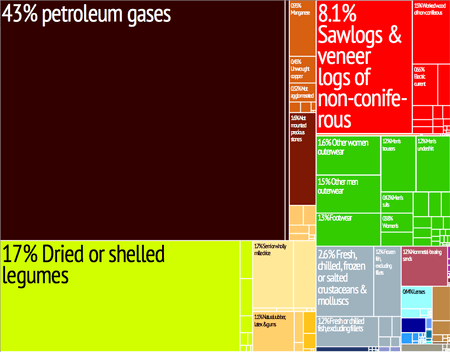
Myanmar is one of the poorest nations in Southeast Asia, suffering from decades of stagnation, mismanagement and isolation. The lack of an educated workforce skilled in modern technology hinders Myanmar's economy, although recent reforms and developments carried out by the new government, in collaboration with foreign countries and organisations, aim to make this a thing of the past.[238] The informal economy's share in Myanmar is one of the biggest in the world and is closely linked to corruption, smuggling and illegal trade activities.[239]
Political and economic ideological struggles have affected living standards. Decades of civil war and unrest have contributed to Myanmar's current levels of poverty and lack of economic progress. Improving basic human, social and economic infrastructure required to advance individual living standards have not received focused government efforts.[240] Myanmar lacks adequate infrastructure. Goods travel primarily across the Thai border (where most illegal drugs are exported) and along the Irrawaddy River. Railways are old and rudimentary, with few repairs since their construction in the late 19th century.[241] Highways are normally unpaved, except in the major cities.[241] In 2010–11, Bangladesh exported products worth $9.65 million to Myanmar against its import of $179 million.[242] The annual import of medicine and medical equipment to Myanmar during the 2000s was USD 160 million.[243]
In recent years, both China and India have attempted to strengthen ties with the government for economic benefit. Many nations, including the United States and Canada, and the European Union, have imposed investment and trade sanctions on Myanmar. The United States and European Union eased most of their sanctions in 2012.[244] Foreign investment comes primarily from China, Singapore, the Philippines, South Korea, India, and Thailand.[245]
The military has the majority stakeholder position in all of the major industrial corporations of the country (from oil production and consumer goods to transportation and tourism).[246][247]
Economic history
Under British administration, Myanmar was the second-wealthiest country in Southeast Asia. It had been the world's largest exporter of rice. Myanmar also had a wealth of natural and labour resources. British Burma began exporting crude oil in 1853, making it one of the earliest petroleum producers in the world.[248] It produced 75% of the world's teak and had a highly literate population.[21] The wealth was however, mainly concentrated in the hands of Europeans. In the 1930s, agricultural production fell dramatically as international rice prices declined and did not recover for several decades.[249] Plans to broaden the new prosperity and extend the reach of modern civilisation were halted by the outbreak of the Second World War.
During the Japanese invasion of the area in World War II, the British followed a scorched earth policy. They destroyed the major government buildings, oil wells and mines for tungsten, tin, lead and silver to keep them from the Japanese. Myanmar was bombed extensively by both sides. After independence, the country was in ruins with its major infrastructure completely destroyed. The British then granted independence to the colony and handed over their plans to rebuild to the new government. After a parliamentary government was formed in 1948, Prime Minister U Nu embarked upon a policy of nationalisation and the state was declared the owner of all land. The government also tried to implement a poorly considered Eight-Year plan. By the 1950s, rice exports had fallen by two-thirds and mineral exports by over 96% (as compared to the pre-World War II period). Plans were partly financed by printing money, which led to inflation.[250]
The 1962 coup d'état was followed by an economic scheme called the Burmese Way to Socialism, a plan to nationalise all industries, with the exception of agriculture. The catastrophic programme turned Myanmar into one of the world's most impoverished countries.[77] Myanmar's admittance to least developed country status by the UN in 1987 highlighted its economic bankruptcy.[251]
Agriculture
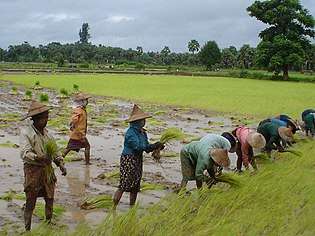
The major agricultural product is rice, which covers about 60% of the country's total cultivated land area. Rice accounts for 97% of total food grain production by weight. Through collaboration with the International Rice Research Institute 52 modern rice varieties were released in the country between 1966 and 1997, helping increase national rice production to 14 million tons in 1987 and to 19 million tons in 1996. By 1988, modern varieties were planted on half of the country's ricelands, including 98 per cent of the irrigated areas.[252] In 2008 rice production was estimated at 50 million tons.[253]
Drug production
Myanmar is also the world's second largest producer of opium, accounting for 25% of entire world production and is a major source of illegal drugs, including amphetamines.[254] Opium bans implemented since 2002 after international pressure have left ex-poppy farmers without sustainable sources of income in the Kokang and Wa regions. They depend on casual labour for income.[255]
Natural resources
Myanmar produces precious stones such as rubies, sapphires, pearls, and jade. Rubies are the biggest earner; 90% of the world's rubies come from the country, whose red stones are prized for their purity and hue. Thailand buys the majority of the country's gems. Myanmar's "Valley of Rubies", the mountainous Mogok area, 200 km (120 mi) north of Mandalay, is noted for its rare pigeon's blood rubies and blue sapphires.[256]
Many U.S. and European jewellery companies, including Bulgari, Tiffany and Cartier, refuse to import these stones based on reports of deplorable working conditions in the mines. Human Rights Watch has encouraged a complete ban on the purchase of Burmese gems based on these reports and because nearly all profits go to the ruling junta, as the majority of mining activity in the country is government-run.[257] The government of Myanmar controls the gem trade by direct ownership or by joint ventures with private owners of mines.[258]
Other industries include agricultural goods, textiles, wood products, construction materials, gems, metals, oil and natural gas.
Myanmar Engineering Society has identified at least 39 locations capable of geothermal power production and some of these hydrothermal reservoirs lie quite close to Yangon which is a significant underutilised resource for electrical production.[259]
Tourism
.jpg)
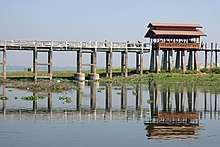
Myanmar's Minister of Hotels and Tourism Saw Lwin has stated that the government receives a significant percentage of the income of private sector tourism services.[260] The most popular available tourist destinations in Myanmar include big cities such as Yangon and Mandalay; religious sites in Mon State, Pindaya, Bago and Hpa-An; nature trails in Inle Lake, Kengtung, Putao, Pyin Oo Lwin; ancient cities such as Bagan and Mrauk-U; as well as beaches in Nabule,[261] Ngapali, Ngwe-Saung, Mergui.[262] Nevertheless, much of the country is off-limits to tourists, and interactions between foreigners and the people of Myanmar, particularly in the border regions, are subject to police scrutiny. They are not to discuss politics with foreigners, under penalty of imprisonment and, in 2001, the Myanmar Tourism Promotion Board issued an order for local officials to protect tourists and limit "unnecessary contact" between foreigners and ordinary Burmese people.[263]
The most common way for travellers to enter the country is by air.[264] According to the website Lonely Planet, getting into Myanmar is problematic: "No bus or train service connects Myanmar with another country, nor can you travel by car or motorcycle across the border – you must walk across." They further state that "It is not possible for foreigners to go to/from Myanmar by sea or river."[264] There are a few border crossings that allow the passage of private vehicles, such as the border between Ruili (China) to Mu-se, the border between Htee Kee (Myanmar) and Phu Nam Ron (Thailand)—the most direct border between Dawei and Kanchanaburi, and the border between Myawaddyand Mae Sot, Thailand. At least one tourist company has successfully run commercial overland routes through these borders since 2013.[265]
Flights are available from most countries, though direct flights are limited to mainly Thai and other ASEAN airlines. According to Eleven magazine, "In the past, there were only 15 international airlines and increasing numbers of airlines have begun launching direct flights from Japan, Qatar, Taiwan, South Korea, Germany and Singapore."[266] Expansions were expected in September 2013 but are mainly Thai and other Asian-based airlines.[266]
Economic sanctions
The government of Myanmar has frequently been under economic sanctions by the U.S. Treasury Department, most recently in 2012.[267] There exists debate as to the extent to which the American-led sanctions have had more adverse effects on the civilian population than on the military rulers.[268][269] From May 2012 to February 2013, the United States began to lift its economic sanctions on Myanmar "in response to the historic reforms that have been taking place in that country."[270] Sanctions remain in place for blocked banks[271] and for any business entities that are more than 50% owned by persons on "OFAC's Specially Designated Nationals and Blocked Persons list (SDN list)".[272] During her first official visit to Washington, D.C., in September 2016, Myanmar's State Counsellor Aung San Suu Kyi met with U.S. President Barack Obama, who announced that long-standing trade sanctions against Myanmar are to be lifted, adding, "It is the right thing to do to ensure the people of Burma see rewards from a new way of doing business, and a new government."[273]
Economic liberalisation, post–2011
In March 2012, a draft foreign investment law emerged, the first in more than 2 decades. Foreigners will no longer need a local partner to start a business in the country, and will be able to legally lease but not own property.[274] The draft law also stipulates that Burmese citizens must constitute at least 25% of the firm's skilled workforce, and with subsequent training, up to 50–75%.[274] In 2012, the Asian Development Bank formally began re-engaging with the country, to finance infrastructure and development projects in the country.[275] The United States, Japan, and the European Union countries have also begun to reduce or eliminate economic sanctions to allow foreign direct investment which will provide the Burmese government with additional tax revenue.[276]
In December 2014, Myanmar signed an agreement to set up its first stock exchange. The Yangon Stock Exchange Joint Venture Co. Ltd will be set up with Myanma Economic Bank sharing 51%, Japan's Daiwa Institute of Research Ltd 30.25% and Japan Exchange Group 18.75%. The Yangon Stock Exchange (YSX) officially opened for business on Friday, 25 March 2016. First Myanmar Investment Co., Ltd. (FMI) became the first stock to be traded after receiving approval for an opening price of 26,000 kyats ($22).[277]
Society
Demographics
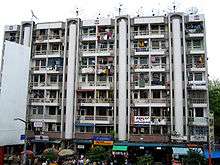
| Population[278][279] | |||
|---|---|---|---|
| Year | Million | ||
| 1950 | 17.1 | ||
| 2000 | 46.1 | ||
| 2018 | 53.7 | ||
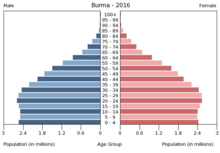
The provisional results of the 2014 Myanmar Census show that the total population is 51,419,420.[280] This figure includes an estimated 1,206,353 persons in parts of northern Rakhine State, Kachin State and Kayin State who were not counted.[281] People who were out of the country at the time of the census are not included in these figures. There are over 600,000 registered migrant workers from Myanmar in Thailand, and millions more work illegally. Burmese citizens account for 80% of all migrant workers in Thailand.[282] The national population density is 76 per square kilometre (200/sq mi), among the lowest in Southeast Asia.
Myanmar's fertility rate as of 2011 is 2.23, which is slightly above replacement level[283] and is low compared to Southeast Asian countries of similar economic standing, such as Cambodia (3.18) and Laos (4.41).[283] There has been a significant decline in fertility in recent years, from a rate of 4.7 children per woman in 1983, down to 2.4 in 2001, despite the absence of any national population policy.[283][284][285] The fertility rate is much lower in urban areas.
The relatively rapid decline in fertility is attributed to several factors, including extreme delays in marriage (almost unparalleled among developing countries in the region), the prevalence of illegal abortions, and the high proportion of single, unmarried women of reproductive age, with 25.9% of women aged 30–34 and 33.1% of men and women aged 25–34 being single.[285][286]
These patterns stem from economic dynamics, including high income inequality, which results in residents of reproductive age opting for delay of marriage and family-building in favour of attempting to find employment and establish some form of wealth;[285] the average age of marriage in Myanmar is 27.5 for men, 26.4 for women.[285][286]
Largest cities
Ethnic groups
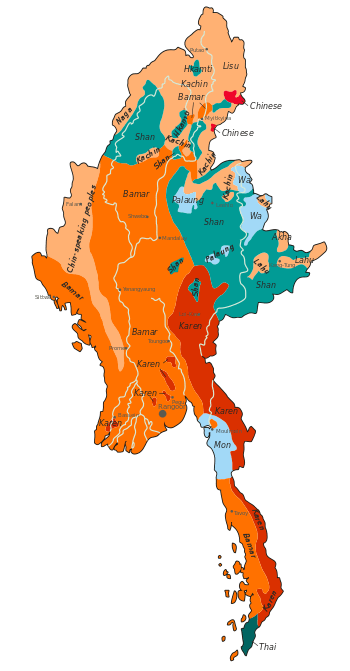
Myanmar is ethnically diverse. The government recognises 135 distinct ethnic groups. There are at least 108 different ethnolinguistic groups in Myanmar, consisting mainly of distinct Tibeto-Burman peoples, but with sizeable populations of Tai–Kadai, Hmong–Mien, and Austroasiatic (Mon–Khmer) peoples.[287]
The Bamar form an estimated 68% of the population.[288] 10% of the population are Shan.[288] The Kayin make up 7% of the population.[288] The Rakhine people constitute 4% of the population. Overseas Chinese form approximately 3% of the population.[288][289] Myanmar's ethnic minority groups prefer the term "ethnic nationality" over "ethnic minority" as the term "minority" furthers their sense of insecurity in the face of what is often described as "Burmanisation"—the proliferation and domination of the dominant Bamar culture over minority cultures.
Mon, who form 2% of the population, are ethno-linguistically related to the Khmer.[288] Overseas Indians are 2%.[288] The remainder are Kachin, Chin, Rohingya, Anglo-Indians, Gurkha, Nepali and other ethnic minorities. Included in this group are the Anglo-Burmese. Once forming a large and influential community, the Anglo-Burmese left the country in steady streams from 1958 onwards, principally to Australia and the UK. It is estimated that 52,000 Anglo-Burmese remain in Myanmar. As of 2009, 110,000 Burmese refugees were living in refugee camps in Thailand.[290]
Refugee camps exist along Indian, Bangladeshi and Thai borders while several thousand are in Malaysia. Conservative estimates state that there are over 295,800 minority refugees from Myanmar, with the majority being Rohingya, Karen, and Karenni are principally located along the Thai-Myanmar border.[291] There are nine permanent refugee camps along the Thai-Myanmar border, most of which were established in the mid-1980s. The refugee camps are under the care of the Thai-Burma Border Consortium (TBBC). Since 2006,[292] over 55,000 Burmese refugees have been resettled in the United States.[293]
The persecution of Burmese Indians, Burmese Chinese and other ethnic groups after the military coup headed by General Ne Win in 1962 led to the expulsion or emigration of 300,000 people.[294] They migrated to escape racial discrimination and the wholesale nationalisation of private enterprise that took place in 1964.[295] The Anglo-Burmese at this time either fled the country or changed their names and blended in with the broader Burmese society.
Many Rohingya Muslims have fled Myanmar. Many refugees headed to neighbouring Bangladesh, including 200,000 in 1978 as a result of the King Dragon operation in Arakan.[296] 250,000 more left in 1991.[297]
Languages
Myanmar is home to four major language families: Sino-Tibetan, Tai–Kadai, Austro-Asiatic, and Indo-European.[298] Sino-Tibetan languages are most widely spoken. They include Burmese, Karen, Kachin, Chin, and Chinese (mainly Hokkien). The primary Tai–Kadai language is Shan. Mon, Palaung, and Wa are the major Austroasiatic languages spoken in Myanmar. The two major Indo-European languages are Pali, the liturgical language of Theravada Buddhism, and English.[299] More than a hundred languages are spoken in total. Since many of them are known only within small tribes around the country, they may have been lost (many if not all) after a few generations.
Burmese, the mother tongue of the Bamar and official language of Myanmar, is related to Tibetan and Chinese.[299] It is written in a script consisting of circular and semi-circular letters, which were adapted from the Mon script, which in turn was developed from a southern Indian script in the 5th century. The earliest known inscriptions in the Burmese script date from the 11th century. It is also used to write Pali, the sacred language of Theravada Buddhism, as well as several ethnic minority languages, including Shan, several Karen dialects, and Kayah (Karenni), with the addition of specialised characters and diacritics for each language.[300]
The Burmese language incorporates widespread usage of honorifics and is age-oriented.[301] Burmese society has traditionally stressed the importance of education. In villages, secular schooling often takes place in monasteries. Secondary and tertiary education take place at government schools.
Religion
Many religions are practised in Myanmar. Religious edifices and orders have been in existence for many years. The Christian and Muslim populations do, however, face religious persecution and it is hard, if not impossible, for non-Buddhists to join the army or get government jobs, the main route to success in the country.[303] Such persecution and targeting of civilians is particularly notable in eastern Myanmar, where over 3,000 villages have been destroyed in the past ten years.[304][305][306] More than 200,000 Muslims have fled to Bangladesh over the last 20 years to escape persecution.[307][308]
A large majority of the population practices Buddhism; estimates range from 80%[309] to 89%.[310] According to 2014 Myanmar Census, 87.9% of the population identifies as Buddhists.[302] Theravāda Buddhism is the most widespread.[310] There are some 500,000 Buddhist monks and 75,000 nuns in this country of 54 million.[311] Other religions are practised largely without obstruction, with the notable exception of some religious minorities such as the Rohingya people, who have continued to have their citizenship status denied and treated as illegal immigrants instead,[191] and Christians in Chin State.[312]
According to 2014 census, 6.2% of the population identifies as Christian; 4.3% as Muslim; 0.8% as followers of tribal religions; 0.5% as Hindus; 0.2% as followers of other religions; and 0.1% follow no religion.[302] According to the 2010 estimates of the Pew Research Center, 7% of the population is Christian; 4% is Muslim; 1% follows traditional animistic beliefs; and 2% follow other religions, including Mahayana Buddhism, Hinduism, and East Asian religions.[313][314] Jehovah's Witnesses have been present since 1914[315] and have about 80 congregations around the country and a branch office in Yangon publishing in 16 languages.[316] A tiny Jewish community in Yangon had a synagogue but no resident rabbi to conduct services.[317]
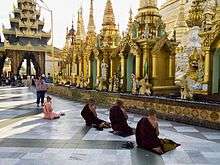
Although Hinduism is practised by 0.5% of the population, it was a major religion in Myanmar's past. Several strains of Hinduism existed alongside both Theravada Buddhism and Mahayana Buddhism in the Mon and Pyu period in the first millennium,[318] and down to the Pagan period (9th to 13th centuries) when "Saivite and Vaishana elements enjoyed greater elite influence than they would later do."[319] Burmese folk religion is practised by many Bamars alongside Buddhism.
Health
The general state of health care in Myanmar is poor. The government spends anywhere from 0.5% to 3% of the country's GDP on health care, consistently ranking among the lowest in the world.[320][321] Although health care is nominally free, in reality, patients have to pay for medicine and treatment, even in public clinics and hospitals. Public hospitals lack many of the basic facilities and equipment. The 2010 maternal mortality rate per 100,000 births for Myanmar is 240. This is compared with 219.3 in 2008 and 662 in 1990. The under 5 mortality rate, per 1,000 births is 73 and the neonatal mortality as a percentage of under 5's mortality is 47. According to the report named "Preventable Fate", published by Doctors without Borders, 25,000 Burmese AIDS patients died in 2007, deaths that could largely have been prevented by antiretroviral therapy drugs and proper treatment.[322]
HIV/AIDS, recognised as a disease of concern by the Burmese Ministry of Health, is most prevalent among sex workers and intravenous drug users. In 2005, the estimated adult HIV prevalence rate in Myanmar was 1.3% (200,000–570,000 people), according to UNAIDS, and early indicators of any progress against the HIV epidemic are inconsistent.[323][324][325] However, the National AIDS Programme Myanmar found that 32% of sex workers and 43% of intravenous drug users in Myanmar have HIV.[325]
Education
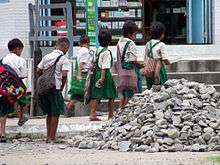
According to the UNESCO Institute of Statistics, Myanmar's official literacy rate as of 2000 was 90%.[326] Historically, Myanmar has had high literacy rates. The educational system of Myanmar is operated by the government agency, the Ministry of Education. The education system is based on the United Kingdom's system after nearly a century of British and Christian presences in Myanmar. Nearly all schools are government-operated, but there has been a recent increase in privately funded English language schools. Schooling is compulsory until the end of elementary school, approximately about 9 years old, while the compulsory schooling age is 15 or 16 at international level.
There are 101 universities, 12 institutes, 9-degree colleges and 24 colleges in Myanmar, a total of 146 higher education institutions.[327] There are 10 technical training schools, 23 nursing training schools, 1 sport academy and 20 midwifery schools. There are four international schools acknowledged by WASC and College Board—The International School Yangon, Myanmar International School, Yangon International School,and International School of Myanmar in Yangon.
Crime
Myanmar had a murder rate of 15.2 per 100,000 population with a total of 8,044 murders in 2012.[328] Factors influencing Myanmar's high murder rate include communal violence and armed conflict.[329] Myanmar is one of the world's most corrupt nations. The 2012 Transparency International Corruption Perceptions Index ranked the country at number 171, out of 176 countries in total.[330] Myanmar is the world's second largest producer of opium after Afghanistan, producing some 25% of the world's opium, and forms part of the Golden Triangle. The opium industry was a monopoly during colonial times and has since been illegally operated by corrupt officials in the Burmese military and rebel fighters,[331] primarily as the basis for heroin manufacture. Myanmar is the largest producer of methamphetamines in the world, with the majority of Ya ba found in Thailand produced in Myanmar, particularly in the Golden Triangle and northeastern Shan State, which borders Thailand, Laos and China.[332] Burmese-produced ya ba is typically trafficked to Thailand via Laos, before being transported through the northeastern Thai region of Isan.[333]
Culture
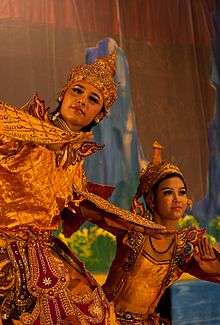
A diverse range of indigenous cultures exist in Myanmar, with majority culture primarily Buddhist and Bamar. Bamar culture has been influenced by the cultures of neighbouring countries, manifested in its language, cuisine, music, dance and theatre. The arts, particularly literature, have historically been influenced by the local form of Theravada Buddhism. Considered the national epic of Myanmar, the Yama Zatdaw, an adaptation of India's Ramayana, has been influenced greatly by Thai, Mon, and Indian versions of the play.[334] Buddhism is practised along with nat worship, which involves elaborate rituals to propitiate one from a pantheon of 37 nats.[335][336]
In a traditional village, the monastery is the centre of cultural life. Monks are venerated and supported by the lay people. A novitiation ceremony called shinbyu is the most important coming of age events for a boy, during which he enters the monastery for a short time.[337] All male children in Buddhist families are encouraged to be a novice (beginner for Buddhism) before the age of twenty and to be a monk after the age of twenty. Girls have ear-piercing ceremonies (နားသ) at the same time.[337] Burmese culture is most evident in villages where local festivals are held throughout the year, the most important being the pagoda festival.[301][338] Many villages have a guardian nat, and superstition and taboos are commonplace.
British colonial rule introduced Western elements of culture to Myanmar. Myanmar's education system is modelled after that of the United Kingdom. Colonial architectural influences are most evident in major cities such as Yangon.[339] Many ethnic minorities, particularly the Karen in the southeast and the Kachin and Chin who populate the north and northeast, practice Christianity.[340] According to The World Factbook, the Burman population is 68% and the ethnic groups constitute 32%. In contrast, the exiled leaders and organisations claim the country is 40% ethnic.
Cuisine
Burmese cuisine is characterised by extensive use of fish products such as fish sauce, ngapi (fermented seafood) and dried prawn. Mohinga is the traditional breakfast dish and is Myanmar's national dish. Seafood is a common ingredient in coastal cities, while meat and poultry are more commonly used in landlocked cities like Mandalay. Freshwater fish and shrimp have been incorporated into inland cooking as a primary source of protein and are used in a variety of ways, fresh, salted whole or filleted, salted and dried, made into a salty paste, or fermented sour and pressed. Burmese cuisine also includes a variety of salads (a thoke), centred on one major ingredient, ranging from starches like rice, wheat and rice noodles, glass noodles and vermicelli, to potato, ginger, tomato, kaffir lime, long bean, and lahpet (pickled tea leaves).
Sport
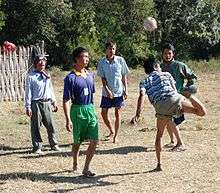
The Lethwei, Bando, Banshay, and Pongyi thaing martial arts and chinlone are traditional sports in Myanmar.[341] Football is played all over the country, even in villages, and its national team is ruled by the Myanmar Football Federation. The 2013 Southeast Asian Games took place in Naypyidaw, Yangon, Mandalay and Ngwesaung Beach in December representing the third occasion that the event has been staged in Myanmar. Myanmar previously hosted the games in 1961 and 1969.[342]
Art
Burmese traditional art concepts are popular and respected by the Burmese people and people from abroad. Burmese contemporary art has developed quite rapidly on its own terms. Artists born after the 1980s have had greater chances of art practice outside the country.
One of the first to study western art was Ba Nyan. Together with Ngwe Gaing and a handful of other artists, they were the pioneers of western painting style. Later on most young children learned the concepts from them. Some well known contemporary artists are Lun Gywe, Aung Kyaw Htet, MPP Yei Myint, Myint Swe, Min Wai Aung, Aung Myint, Kin Maung Yin, Po Po and Zaw Zaw Aung.
Media and communications
Because of Myanmar's political climate, there are not many media companies in relation to the country's population. Some are privately owned. All programming must meet with the approval of the censorship board. The Burmese government announced on 20 August 2012 that it would stop censoring media before publication. Following the announcement, newspapers and other outlets no longer required approved by state censors; however, journalists in the country can still face consequences for what they write and say.[343] In April 2013, international media reports were published to relay the enactment of the media liberalisation reforms that we announced in August 2012. For the first time in numerous decades, the publication of privately owned newspapers commenced in the country.[344]
Internet
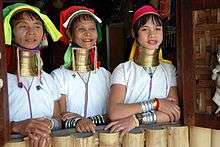
Internet use is estimated to be relatively low compared to other countries.[345] Myanmar's internet used to be subject to censorship, and authorities viewed e-mails and posts on Internet blogs until 2012 when the government removed media censorship. During the strict censorship days, activity at internet cafes was regulated, and one blogger named Zarganar was sentenced to prison for publishing a video of destruction caused by Cyclone Nargis in 2008; Zarganar was released in October 2011.
In regards to communications infrastructure, Myanmar is the last ranked Asian country in the World Economic Forum's Network Readiness Index (NRI) – an indicator for determining the development level of a country's information and communication technologies. With 139 countries reported on, Myanmar ranked number 133 overall in the 2016 NRI ranking.[346]
Film
Myanmar's first film was a documentary of the funeral of Tun Shein—a leading politician of the 1910s, who campaigned for Burmese independence in London. The first Burmese silent film Myitta Ne Thuya (Love and Liquor) in 1920 which proved a major success, despite its poor quality due to a fixed camera position and inadequate film accessories. During the 1920s and 1930s, many Burmese-owned film companies made and produced several films. The first Burmese sound film was produced in 1932 in Bombay, India with the title Ngwe Pay Lo Ma Ya (Money Can't Buy It). After World War II, Burmese cinema continued to address political themes. Many of the films produced in the early Cold War era had a strong propaganda element to them.
In the era that followed the political events of 1988, the film industry has been increasingly controlled by the government. Film stars who had been involved in the political activities were banned from appearing in films. The government issues strict rules on censorship and largely determines who produces films, as well as who gets academy awards.[347]
Over the years, the movie industry has also shifted to producing many lower-budget direct-to-video films. Most of the movies produced nowadays are comedies.[348] In 2008, only 12 films worthy of being considered for an Academy Award were made, although at least 800 VCDs were produced.[349] Myanmar is the primary subject of a 2007 graphic novel titled Chroniques Birmanes by Québécois author and animator, Guy Delisle. The graphic novel was translated into English under the title Burma Chronicles in 2008. In 2009, a documentary about Burmese videojournalists called Burma VJ was released.[350] This film was nominated for Best Documentary Feature at the 2010 Academy Awards.[351] The Lady had its world premiere on 12 September 2011 at the 36th Toronto International Film Festival.[352]
Notes
- The final r in Myanmar is not intended for pronunciation but exists to represent the broad ah (/ɑː/) sound of British English.
- Burmese: ပြည်ထောင်စု သမ္မတ မြန်မာနိုင်ငံတေ, [pjìdàʊɴzṵ θàɴməda̰ mjəmà nàɪɴŋàɴdɔ̀]
- Based on the estimated overall population, including both the enumerated and non-enumerated population (51,486,253), and on the assumption that the non-enumerated population in Rakhine State affiliate with the Islamic faith.
References
- "Burma". The World Factbook. U.S. Central Intelligence Agency. Archived from the original on 6 October 2010.
- "The 2014 Myanmar Population and Housing Census- The Union Report: Religion" (PDF). myanmar.unfpa.org. Department of Population Ministry of Labour, Immigration and Population MYANMAR. Archived from the original (PDF) on 29 March 2018. Retrieved 3 February 2019.
- "ACT Health Community Profile, pg. 1" (PDF). Multicultural Health Policy Unit. Archived from the original (PDF) on 11 April 2015. Retrieved 5 August 2018.
- "Myanmar Population (2018) – Worldometers". worldometers.info.
- "World Economic Outlook Database, October 2019". IMF.org. International Monetary Fund. Retrieved 3 January 2020.
- "GINI index (World Bank estimate)". data.worldbank.org. World Bank. Retrieved 5 March 2019.
- "Human Development Report 2019" (PDF). United Nations Development Programme. 2019. Retrieved 9 December 2019.
- O'Reilly, Dougald JW (2007). Early civilizations of Southeast Asia. United Kingdom: Altamira Press. ISBN 978-0-7591-0279-8.
- Lieberman, p. 152
- "Burma". Human Rights Watch. Retrieved 6 July 2013.
"Myanmar Human Rights". Amnesty International USA. Retrieved 6 July 2013.
"World Report 2012: Burma". Human Rights Watch. 22 January 2012. Archived from the original on 30 June 2013. Retrieved 6 July 2013. - Madhani, Aamer (16 November 2012). "Obama administration eases Burma sanctions before visit". USA Today.
Fuller, Thomas; Geitner, Paul (23 April 2012). "European Union Suspends Most Myanmar Sanctions". The New York Times. - Greenwood, Faine (27 May 2013). "The 8 Stages of Genocide Against Burma's Rohingya | UN DispatchUN Dispatch". Undispatch.com. Retrieved 13 April 2014.
"EU welcomes "measured" Myanmar response to rioting". Reuters. 11 June 2012.
"Q&A: Communal violence in Burma". BBC. Retrieved 14 October 2013. - Vakulchuk, Roman; Kyaw Kyaw Hlaing; Edward Ziwa Naing; Indra Overland; Beni Suryadi and Sanjayan Velautham (2017). Myanmar’s Attractiveness for Investment in the Energy Sector. A Comparative International Perspective. Norwegian Institute of International Affairs (NUPI) and Myanmar Institute of Strategic and International Studies (MISIS) Report. p. 8.
- "Burma (Myanmar)". World Economic Outlook Database. International Monetary Fund.
- Eleven Media (4 September 2013). "Income Gap 'world's widest'". The Nation. Archived from the original on 15 September 2014. Retrieved 15 September 2014.
McCornac, Dennis (22 October 2013). "Income inequality in Burma". Democratic Voice of Burma. Archived from the original on 15 September 2014. Retrieved 15 September 2014. - "What's in a Name: Burma or Myanmar?". United States Institute of Peace. Retrieved 27 April 2020.
- "Should it be Burma or Myanmar?". 26 September 2007. Retrieved 27 April 2020.
- Hall, DGE (1960). "Pre-Pagan Burma". Burma (3 ed.). p. 13.
- Houtman, Gustaaf (1999). Mental Culture in Burmese Crisis Politics: Aung San Suu Kyi and the National League for Democracy. ILCAA. p. 352. ISBN 9784872977486.
- Houtman, Gustaaf (1999). Mental culture in Burmese crisis politics. ILCAA Study of Languages and Cultures of Asia and Africa Monograph Series No. 33. Institute for the Study of Languages and Cultures of Asia and Africa. pp. 43–54. ISBN 978-4-87297-748-6.
- Steinberg, David I. (2002). Burma: The State of Myanmar. Georgetown University Press. p. xi. ISBN 978-1-58901-285-1.
- South China Morning Post, "What's in a name? Not much, according to Aung San Suu Kyi, who tells diplomats they can use Myanmar or Burma", Saturday, 23 April 2016
- "NCGUB". National Coalition Government of the Union of Burma. Archived from the original on 9 September 2015. Retrieved 3 May 2012.
- "Burma or Myanmar? Obama calls it both on visit". Asian Correspondent. Bristol, England: Hybrid News Limited. Associated Press. 19 November 2012. Retrieved 19 November 2012.
Yangon, Burma (AP) – Officially at least, America still calls this Southeast Asian nation Burma, the favoured appellation of dissidents and pro-democracy activists who opposed the former military junta's move to summarily change its name 23 years ago.
Jason Burke (19 November 2012). "Burma v Myanmar – what's in a name? Obama plays it safe during historic visit". The Guardian.
"Burma (Myanmar)". United States Department of State. Archived from the original on 20 October 2013. Retrieved 13 April 2014. - Dittmer, Lowell (2010). Burma Or Myanmar? The Struggle for National Identity. World Scientific. p. 2. ISBN 9789814313643.
- "Special Economic Measures (Burma) Regulations". Government of Canada – Justice Laws Website. 25 June 2018. Retrieved 15 November 2018.
- "Canada and Myanmar relations". Government of Canada – Global Affairs Canada. Retrieved 15 November 2018.
- "The Ministry of Foreign Affairs of the Czech Republic provides CZK 2.5 million of immediate assistance to flood victims in Myanmar/Burma". Ministry of Foreign Affairs of the Czech Republic. 7 August 2015. Retrieved 8 November 2015.
- "Countries, economies and regions – Myanmar". Department of Foreign Affairs and Trade, Australian Government. Retrieved 14 September 2016.
- "Burma vs. Myanmar: What's in a Name". DW. 1 September 2007. Retrieved 2 August 2013.
- Mudditt, Jassica (19 November 2012). "Burma or Myanmar: Will the US make the switch?". Retrieved 2 August 2013.
- "Representations and travel advice – Myanmar". Federal Department of Foreign Affairs. Retrieved 14 September 2016.
- "Myanmar profile". BBC News. 16 July 2013.
- "Myanmar Fast Facts". CNN. 30 July 2013.
- "Myanmar blast hits anti-Muslim monk's event – Asia-Pacific". Al Jazeera. 22 July 2013.
- "Myanmar". Reuters. 9 February 2009.
- Woodley, Naomi (12 July 2013). "Carr apprehensive about Rohingyas' future in Myanmar". AM. Australian Broadcasting Corporation. Retrieved 14 September 2016.
"Aung San Suu Kyi arrives in Thailand for official visit". Radio Australia. 23 June 2016. Retrieved 14 September 2016. - "'Birmanie ou Myanmar ? Le vrai faux débat francophone' – La France en Birmanie". Ambafrance-mm.org. Archived from the original on 8 April 2014. Retrieved 13 April 2014.
- "Birmanie: 87.000 Rohingyas réfugiés au Bangladesh en dix jours, selon l'ONU". L'Obs. 4 September 2017. Retrieved 9 September 2017.
- "L'actualité sur Birmanie par L'Obs". L'Obs.
- Martha Figueroa-Clark (26 September 2007). "How to say Myanmar". Magazine Monitor. An occasional guide to the words and names in the news from Martha Figueroa-Clark of the BBC Pronunciation Unit. BBC.
"Definition of Myanmar – Oxford Dictionaries (British & World English)". Oxford Dictionaries. Retrieved 1 September 2012.
"Myanmar". Thefreedictionary.com. Retrieved 6 July 2013.
Thackrah, J. R. "Definition of Myanmar". Collins English Dictionary. Retrieved 1 September 2012.
"Myanmar – Definition and More from the Free Merriam-Webster Dictionary". Merriam-webster.com. Retrieved 1 September 2012.
Ammon, Ulrich (2004). Sociolinguistics: An International Handbook of the Science of Language and Society. Volume 3/3 (2nd ed.). Walter de Gruyter. p. 2012. ISBN 978-3-11-018418-1. - Win Naing Tun (24 July 2015). "Prehistory to Protohistory of Myanmar: A Perspective of Historical Geography" (PDF). Myanmar Environment Institute. p. 1. Retrieved 22 November 2016.
Homo erectus had lived in Myanmar 750,000 years ago
Bowman, John Stewart Bowman (2013). Columbia Chronologies of Asian History and Culture. Columbia University Press. p. 476. ISBN 978-0-231-50004-3. - Schaarschmidt, Maria; Fu, Xiao; Li, Bo; Marwick, Ben; Khaing, Kyaw; Douka, Katerina; Roberts, Richard G. (January 2018). "pIRIR and IR-RF dating of archaeological deposits at Badahlin and Gu Myaung Caves – First luminescence ages for Myanmar". Quaternary Geochronology. 49: 262–270. doi:10.1016/j.quageo.2018.01.001.
- Cooler, Richard M. (2002). "The Art and Culture of Burma (Chapter 1)". DeKalb: Northern Illinois University.
- Myint-U, p. 37
- Yee Yee Aung. "Skeletal Remains of Nyaunggan, Budalin Township, Monywa District, Sagaing Division". Perspective July 2002. Retrieved 7 October 2008.
- Myint-U, p. 45
- Hudson, Bob (March 2005). "A Pyu Homeland in the Samon Valley: a new theory of the origins of Myanmar's early urban system" (PDF). Myanmar Historical Commission Golden Jubilee International Conference: 1. Archived from the original (PDF) on 26 November 2013.
- Coupey, A. S. (2008). Infant and child burials in the Samon valley, Myanmar. In Archaeology in Southeast Asia, from Homo Erectus to the living traditions: choice of papers from the 11th International Conference of the European Association of Southeast Asian Archaeologists, 25–29 September 2006, Bougon, France
- Hall, D.G.E. (1960). Burma (3rd ed.). Hutchinson University Library. pp. 8–10. ISBN 978-1-4067-3503-1.
Moore, Elizabeth H. (2007). Early Landscapes of Myanmar. Bangkok: River Books. p. 236. ISBN 978-974-9863-31-2. - Myint-U, pp. 51–52
- Lieberman, pp. 90–91
- Lieberman, p. 24
- Htin Aung, Maung (1967). A History of Burma. New York and London: Cambridge University Press. pp. 63–65.
- Maung Maung Tin, Vol. 2, p. 25
- Lieberman, p. 134
- Myint-U, pp. 64–65
- Lieberman, pp. 184–187
- Myint-U, p. 109
- Lieberman, pp. 202–206
- Baten, Jörg (2016). A History of the Global Economy. From 1500 to the Present. Cambridge University Press. p. 287. ISBN 978-1-107-50718-0.
- Collis, Maurice (1945). Trials in Burma.
- Bechert, Heinz (1984). The World of Buddhism-Buddhist Monks and Nuns in Society and Culture. New York, N.Y.: Facts on File. ISBN 978-0-87196-982-8.
- Bennett, Will (20 August 1995). "Chindits remember their fallen comrades". The Independent. London. Retrieved 20 November 2012.
- "China-Burma-India: Merrill's Marauders. Veterans History Project, Library of Congress". Loc.gov. 14 November 2012. Retrieved 20 November 2012.
- Towle, Philip; Kosuge, Margaret; Kibata, Yōichi (2000). Japanese prisoners of war. Continuum International Publishing Group. p. 48. ISBN 978-1-85285-192-7.
- Fellowes-Gordon, Ian (1971). The Battle For Naw Seng's Kingdom: General Stilwel.
- Michael Clodfelter. Warfare and Armed Conflicts: A Statistical Reference to Casualty and Other Figures, 1500–2000. 2nd Ed. 2002 ISBN 0-7864-1204-6. p. 556
Werner Gruhl, Imperial Japan's World War Two, 1931–1945 Transaction 2007 ISBN 978-0-7658-0352-8 (Werner Gruhl is former chief of NASA's Cost and Economic Analysis Branch with a lifetime interest in the study of the First and Second World Wars.) - Moe, Kyaw Zwa (August 1977). "Author Discusses Martyrs' Day Assassination of Aung San". The Irrawaddy.
- Houtman, Gustaaf (1999). Mental Culture in Burmese Crisis Politics: Aung San Suu Kyi and the National League for Democracy. Tokyo: Tokyo University of Foreign Studies, Institute for the Study of Languages and Cultures of Asia and Africa. ISBN 978-4-87297-748-6.
- "The Constitution of the Union of Burma". DVB. 1947. Archived from the original on 15 June 2006. Retrieved 7 July 2006.
- Smith, Martin (1991). Burma -Insurgency and the Politics of Ethnicity. London and New Jersey: Zed Books. pp. 42–43.
- Zaw, Aung (September 2006). "Can Another Asian Fill U Thant's Shoes?". The Irrawaddy. 14 (9). Archived from the original on 14 March 2012.
- Kipgen, Nehginpao (23 May 2017). "The united states of Myanmar?". The Hindu. Retrieved 9 September 2017.
- Myint-U
- Fink, Christina (2001). Living Silence: Burma under Military Rule. Bangkok: White Lotus. ISBN 978-1-85649-926-2.
- Tallentire, Mark (28 September 2007). "The Burma road to ruin". The Guardian. London.
- "Pyithu Hluttaw Election Law". State Law and Order Restoration Council. iBiblio.org. 31 May 1989. Retrieved 11 July 2006.
- Han, Khin Kyaw (1 February 2003). "1990 Multi-party Democracy General Elections". National League for Democracy. iBiblio.org.
- "Burma's new capital stages parade". BBC News. 27 March 2006. Retrieved 24 June 2006.
- "Burma leaders double fuel prices". BBC News. 15 August 2007. Retrieved 20 November 2012.
Booth, Jenny (24 September 2007). "Military junta threatens monks in Burma". The Times. London. Retrieved 27 April 2010.
"100,000 Protestors Flood Streets of Rangoon in "Saffron Revolution"".
Fink, Christina (2009). "The Moment of the Monks: Burma, 2007". In Adam Roberts; Timothy Garton Ash (eds.). Civil Resistance and Power Politics: The Experience of Non-violent Action from Gandhi to the Present. Oxford University Press. pp. 354–70. ISBN 978-0-19-955201-6.
"UN envoy warns of Myanmar crisis". English.aljazeera.net. Archived from the original on 28 February 2008. Retrieved 20 November 2012. - Fountain, Henry (6 May 2008). "Aid arrives in Myanmar as death toll passes 22,000, but worst-hit area still cut off –". International Herald Tribune. Archived from the original on 11 October 2008.
- "Official: UN plane lands in Myanmar with aid after cyclone". Associated Press. Retrieved 6 August 2015.
- Stevenson, Rachel; Borger, Julian & MacKinnon, Ian (9 May 2008). "Burma snubs foreign aid workers". The Guardian. London.
- "Burma: imperialists exploit natural disaster to promote regime change". Proletarian Online. June 2008.
- "Fighting forces up to 30,000 to flee Myanmar". NBC News. 28 August 2009. Retrieved 20 November 2012.
- "More fighting feared as thousands flee Burma". Bangkok Post. Agence France-Presse. 27 August 2009. Retrieved 28 August 2009.
- Fuller, Thomas (28 August 2009). "Refugees Flee to China as Fighting Breaks Out in Myanmar". The New York Times. Retrieved 28 August 2009.
- "Thousands Flee Burma Violence". BBC News. 26 August 2009. Retrieved 28 August 2009.
- "Restricted Areas in Burma". Tourism Burma. 2013. Archived from the original on 2 January 2013. Retrieved 27 March 2013.
- Fuller, Thomas (4 April 2013). "Ethnic Rifts Strain Myanmar as It Moves Toward Democracy". The New York Times.
- Nadi, Nang Mya (25 September 2012). "Displaced by fighting, villagers take shelter in Hpakant". Democratic Voice of Burma. Archived from the original on 27 November 2012. Retrieved 27 March 2013.
"Blood and Gold: Inside Burma's Hidden War". Al Jazeera. 4 October 2012. - "About 75,000 Rohingyas in Myanmar camps: Refugee International". The Hindu. Chennai, India. 29 September 2012. Retrieved 27 March 2013.
- Power, Samantha (9 November 2012). "Supporting Human Rights in Burma". The White House Blog. The White House. Retrieved 27 March 2013.
"Myanmar Shan refugees struggle at Thai border". Al Jazeera. 2 October 2012. - Saw Khar Su Nyar (KIC) (16 March 2012). "Karen fighters and Burma Army soldiers killed over ceasefire breach". Karen News. Archived from the original on 15 June 2013. Retrieved 27 March 2013.
- "Myanmar: Karen groups cautious on peace initiative". IRIN. 5 March 2012.
- "Concern in India as Al Qaeda announces new India front". Myanmar News.Net. 4 September 2014. Retrieved 6 September 2014.
- "Myanmar Muslim group rejects Al Qaeda statement". Myanmar News.Net. 6 September 2014. Retrieved 6 September 2014.
- "Tens of thousands flee war, airstrikes in Kokang region". DVB Multimedia Group. 12 February 2015. Archived from the original on 28 March 2015. Retrieved 31 March 2015.
- "Myanmar Kokang Rebels Deny Receiving Chinese Weapons". Radio Free Asia.
- Marshall, Andrew (11 April 2011). "The Slow Thaw of Burma's Notorious Military Junta". The Times. UK. Retrieved 1 September 2011.
- "A Changing Ethnic Landscape: Analysis of Burma's 2010 Polls". Transnational Institute – Burma Project. TNI. 14 December 2010. Retrieved 27 March 2013.
- MacFarquhar, Neil (21 October 2010). "U.N. Doubts Fairness of Election in Myanmar". The New York Times.
- Bunte, M. (2013). "Burma's Transition to Quasi-Military Rule: From Rulers to Guardians?". Armed Forces & Society. 40 (4): 742. doi:10.1177/0095327X13492943.
- Loyn, David (19 November 2011). "Obstacles lie ahead in Burma's bid for reform". BBC. Retrieved 20 November 2011.
- Cabellero-Anthony, Mely (March 2014). ""Myanmar's Chairmanship of ASEAN: Challenges and Opportunities", Myanmar's Growing Regional Role". NBR Special Report.
- Hepler, Lauren; Voorhees, Josh (1 December 2011). "Budding Friendship on Display as Clinton, Burma's Suu Kyi Meet Again". Slate. Associated Press. Archived from the original on 17 June 2013.
Wrapping up a historic three-day visit to Myanmar [Burma], the first by a secretary of state to the Southeast Asian nation in more than 50 years
- Myers, Steven Lee (2 December 2011). "Clinton Says U.S. Will Relax Some Restrictions on Myanmar". The New York Times. p. A6. Retrieved 15 May 2013.
- "US Secretary of State Hillary Clinton to visit Burma". BBC. 18 November 2011. Retrieved 25 November 2011.
- Golluoglu, Esmer (4 February 2012). "Aung San Suu Kyi hails 'new era' for Burma after landslide victory". The Guardian. London.
- "Suu Kyi's National League for Democracy Wins Majority in Myanmar". BBC News. 13 November 2015. Retrieved 13 November 2015.
- "Suu Kyi's novice MPs learn ropes in outgoing Myanmar parliament". Channel NewsAsia. Archived from the original on 27 January 2016. Retrieved 28 January 2016.
- Moe, Wae; Ramzy, Austin (15 March 2016). "Myanmar Lawmakers Name Htin Kyaw President, Affirming Civilian Rule". The New York Times.
- Patrick Hesp; et al., eds. (2000). Geographica's World Reference. Random House Australia. pp. 738, 741.
- Than, Mya (2005). Myanmar in ASEAN: Regional Co-operation Experience. Singapore: Institute of Southeast Asian Studies. ISBN 978-9812302106.
- Thein, Myat (2005). Economic Development of Myanmar. Singapore: Inst. of Southeast Asian Studies. ISBN 978-9812302113.
- "Myanmar. States & Regions". Myanmar's NET. Archived from the original on 4 November 2013.
- List of Districts, Townships, Cities/Towns, Wards, Village Groups and Villages in Union of Myanmar published by Ministry of Home Affairs, Government of Union of Myanmar on 31 December 2001
- "2016 Report". EPI Report. Archived from the original on 4 February 2016. Retrieved 17 December 2016.
- EPI (2016): Myanmar Archived 24 April 2017 at the Wayback Machine
- Overland, I. et al. (2017). Impact of Climate Change on ASEAN International Affairs: Risk and Opportunity Multiplier. Norwegian Institute of International Affairs (NUPI) and Myanmar Institute of International and Strategic Studies (MISIS).
- "Myanmar's Forest Law and Rules n". BurmaLibrary.org. Retrieved 15 July 2006.
- Reid, Robert; Bindloss, Joseph; Butler, Stuart (2009). "Environment: National Parks". Myanmar (Burma) (10th ed.). Footscray, Victoria, Australia: Lonely Planet. p. 85. ISBN 978-1-74104-718-9.
- ""Flora and Fauna" at". Myanmars.net. Archived from the original on 23 September 2006. Retrieved 17 April 2010.
- "Reuters, Cyclone-hit Myanmar says 92 percent back charter". Reuters. 15 May 2008. Retrieved 17 April 2010.
- MacFarquhar, Neil (22 October 2010). "U.N. Doubts Fairness of Election in Myanmar". The New York Times.
- Jha, Lalit K (21 May 2009). "2010 Burmese Election may be Illegitimate: Clinton". The Irrawaddy. Retrieved 15 May 2013.
- "Western states dismiss Burma's election". BBC. 8 November 2010. Retrieved 11 November 2010.
- Tisdall, Simon (4 July 2011). "Aung San Suu Kyi has to tread softly – but governments must tell it like it is". The Guardian. UK.
- Walker, Peter (12 November 2010). "Guardian report on Aung's release from house arrest". The Guardian. London. Retrieved 1 September 2012.
- "Suu Kyi's NLD democracy party to rejoin Burma politics". BBC. 18 November 2011. Retrieved 18 November 2011.
- "Myanmar under Transition". Asian Review. Retrieved 9 February 2017.
- Fisher, Jonah (8 July 2016). "Hundred days of Myanmar's democracy". BBC News. Retrieved 9 February 2017.
- "Corruption Perceptions Index 2019". Transparency.org. Retrieved 14 August 2020.
- "Burma Freedom and Democracy Act of 2003". United States Library of Congress. 4 June 2003. Archived from the original on 25 January 2004. Retrieved 4 February 2007.
- Myers, Steven Lee; Mydans, Seth (13 January 2012). "U.S. to Renew Myanmar Ties in Light of Reforms". The New York Times. Retrieved 15 May 2013.
- "The EU's relations with Burma / Myanmar". European Union. Archived from the original on 25 July 2006. Retrieved 13 July 2006.
- "Overview of Burma sanctions". BBC. 18 December 2009. Archived from the original on 12 August 2011. Retrieved 12 November 2011.
- "David Cameron calls for Myanmar sanctions to be suspended". BBC News. 13 April 2012.
- "Burma, India to sign accord on use of India's remote sensing satellite data". NewsLibrary.com. 9 March 2006. Archived from the original on 1 May 2011. Retrieved 17 April 2010.
- "India looks to Burma to slake growing thirst for gas". The Christian Science Monitor. 26 April 2006. Retrieved 17 April 2010.
- "Myanmar, India to build IT centres in Myanmar_English_Xinhua". Xinhua News Agency. 4 August 2008. Retrieved 17 April 2010.
- "India to develop two hydel power projects in Myanmar – 56908". Steelguru.com. 1 August 2008. Archived from the original on 16 January 2009. Retrieved 20 November 2012.
- "BBC News". 2 January 2008. Retrieved 17 April 2010.
- "India and Burma: time to choose (Human Rights Watch, 14-1-2008)". Human Rights Watch. Archived from the original on 7 December 2009. Retrieved 17 April 2010.
- "The Barefoot Diplomat: Hillary Clinton Begins Landmark Visit to Burma". Time. 1 December 2011. Retrieved 19 November 2012.
U.S. Secretary of State Hillary Clinton and pro-democracy opposition leader Aung San Suu Kyi talk prior to dinner in Rangoon, Myanmar, 1 Dec. 2011.
- "Myanmar's Suu Kyi begins landmark US visit" (News & blogging). Asian Correspondent. Bristol, England: Hybrid News Limited. Associated Press. 17 September 2012. Retrieved 19 November 2012.
WASHINGTON (AP) – Burma democracy leader Aung San Suu Kyi will be honored in Washington this week and presented Congress's highest award, the latest milestone in her remarkable journey from political prisoner to globe-trotting stateswoman.
- "Burma's president to make historic US visit" (News & blogging). Asian Correspondent. Bristol, England: Hybrid News Limited. Associated Press. 24 September 2012. Retrieved 19 November 2012.
YANGON, Myanmar (AP) – Myanmar's reformist president is heading to the United States to tout his country's makeover and push for an end to sanctions, in the first U.S. visit by a leader of the former international pariah since 1966.
- "Obama Vows US Support As Myanmar Leader Visits". NPR. Associated Press. 20 May 2013. Archived from the original on 21 May 2013.
- "Pheonix Voyages appointed travel manager for Myanmar's first major summit". TTGmice. Archived from the original on 10 November 2013. Retrieved 29 April 2013.
- "Which Countries Are For or Against China's Xinjiang Policies?". The Diplomat. 15 July 2019.
- Cody, Edward (27 September 2007). "Caution by Junta's Asian Neighbors Reflects Their Self-Interest". The Washington Post. Retrieved 17 April 2010.
- "24th ASEAN Summit, Nay Pyi Taw, Myanmar, 10–11 May 2014". ASEAN (Press release). 4 April 2014. Archived from the original on 16 April 2016.
- "24th ASEAN Summit, Nay Pyi Taw, Myanmar, 10–11 May 2014". ASEAN. 4 April 2014. Archived from the original on 16 April 2016. Retrieved 1 April 2016.
- "For Rohingya in Bangladesh, No Place is Home". Time. 19 February 2010.
- Starck, Peter (7 June 2005). "World Military Spending Topped US$1 trillion in 2004". Common Dreams NewsCenter. Reuters. Archived from the original on 20 June 2006. Retrieved 19 July 2006.
- "Russia and Burma in Nuclear Deal". BBC. 15 May 2007. Archived from the original on 19 August 2007. Retrieved 28 September 2011.
- Moore, Malcolm (14 January 2011). "Nuclear Watchdog asks Burma to Open Up Suspect Sites". The Telegraph. London. Retrieved 28 September 2011.
- "Alleged North Korean Involvement in Missile Assembly and Underground Facility Construction in Burma". Wikileaks.ch. 27 August 2004. Archived from the original on 13 December 2010.
- United Nations General Assembly Session 54 Verbotim Report 83. A/54/PV.83 page 30. The President 17 December 1999 at 10:00.
- United Nations General Assembly Session 55 Verbotim Report 81. A/55/PV.81 page 22. The President 4 December 2000 at 15:00.
- United Nations General Assembly Session 56 Verbotim Report 92. A/56/PV.92 page 7. 24 December 2001 at 11:00.
- United Nations General Assembly Session 60 Verbotim Report 69. A/60/PV.69 page 19. The President 23 December 2005 at 10:00.
- United Nations General Assembly Session 61 Verbotim Report 84. A/61/PV.84 page 14. 22 December 2006 at 10:00.
- United Nations Security Council Document 14. S/2007/14 12 January 2007.
- United Nations Security Council Verbotim Report 5619. S/PV/5619 page 3. Mr. Kumalo South Africa 12 January 2007 at 16:00.
- "The World's Most Repressive Regimes 2013" (PDF). Geneva: Freedom House. 2003. pp. vii–7.
Burma continues to be ruled by one of the world's most repressive regimes.
- Howse, Robert; Jared M. Genser. "Are EU Trade Sanctions on Burma Compatible With WTO Law?" (PDF). Are EU Trade Sanctions on Burma Compatible with WTO Law?: 166 ff. Archived from the original (PDF) on 7 June 2010. Retrieved 7 November 2010.
repressive and abusive military regime
- "List of UN General Assembly Resolutions on Burma". Archived from the original on 4 November 2016. Retrieved 4 January 2010.
- "UN General Assembly Resolution: Time for Concrete Action" (Press release). International Federation for Human Rights. 20 November 2009. Retrieved 4 January 2010.
- Adams, Brad (1 September 2004). "Statement to the EU Development Committee". Human Rights Watch. Archived from the original on 20 June 2006. Retrieved 12 July 2006.
- Adams, Brad. "Amnesty International 2009 Report on Human Rights in Myanmar". Amnesty International. Archived from the original on 12 September 2009. Retrieved 4 January 2010.
- "Satellite Images Verify Myanmar Forced Relocations, Mounting Military Presence". ScienceMode. 28 September 2007. Archived from the original on 26 February 2008.
- "Myanmar set to release some 70 prisoners". The Myanmar Times. 24 July 2013. Retrieved 24 July 2013.
- Weng, Lawi (24 July 2013). "Burma Govt Releases 73 Political Prisoners". Retrieved 24 July 2013.
- "Myanmar: Final push on political prisoners needed". 27 September 2012. Retrieved 19 March 2013.
- "Burma Frees 56 Political Prisoners". Voice of America. 22 April 2013. Retrieved 26 April 2013.
- Guardia, Anton La (24 June 2005). "Myanmar's 'slow genocide' is revealed through the eyes of its child victims". The Telegraph. London. Retrieved 20 November 2012.
- "2013 UNHCR country operations profile – Thailand". Retrieved 15 May 2013.
- Taylor, Jerome (19 June 2012). "Two Burmese children a week conscripted into military". The Independent. London. Retrieved 15 May 2013.
- "Press Conference on Action Plan to End Recruitment of Child Soldiers in Myanmar". United Nations. 5 July 2012. Retrieved 6 July 2013.
- Weng, Lawi (5 September 2012). "ILO in Talks with Kachins over Child Soldiers". The Irrawaddy. Retrieved 15 May 2013.
- "Myanmar: 10th anniversary of military repression". Amnesty International. 7 August 1998. Archived from the original on 24 August 2006. Retrieved 14 July 2006.
- "State of Terror report" (PDF). Women's League of Burma. 1 February 2007. Archived from the original (PDF) on 28 May 2007. Retrieved 21 May 2007.
- "The Trafficking Situation".
- "Burma". Archived from the original on 25 July 2018.
- "Myanmar UN ACT". UN ACT.
- "Give Us a Baby and We'll Let You Go: Trafficking of Kachin Brides from Myanmar to China". Human Rights Watch. 21 March 2019.
- "Trapped inside Myanmar's refugee camps, the Rohingya people call for recognition". The Guardian. 20 December 2012. Retrieved 10 February 2015.
- "US Holocaust Museum highlights plight of Myanmar's downtrodden Rohingya Muslims". Fox News Channel. Associated Press. 6 November 2013.
- Head, Jonathan (5 February 2009). "What drive the Rohingya to sea?". BBC. Retrieved 29 July 2012.
- 2000 Human Rights Report III. Discrimination in Arakan, Human Rights Watch, retrieved 14 December 2014
- Islam, Syed; Islam, Serajul (2007). "Chapter 16, State Terrorism in Arakan". In Tan, Andrew T. H. (ed.). A Handbook of Terrorism and Insurgency in South East Asia. Edward Elgar Publishing. p. 342. ISBN 978-1-84542-543-2.
- Hindstrom, Hanna (25 July 2012). "Burma's monks call for Muslim community to be shunned". The Independent. Retrieved 15 September 2014.
- Dummett, Mark (18 February 2010). "Bangladesh accused of 'crackdown' on Rohingya refugees". BBC. Retrieved 29 July 2012.
- "Myanmar, Bangladesh leaders 'to discuss Rohingya'". Agence France-Presse. 25 June 2012. Retrieved 15 September 2014.
- Bento, Lucas & Yusuf, Guled (9 October 2012). "The Rohingya: Unwanted at Home, Unwelcome Abroad". The Diplomat.
- Tim MclaughLin (8 July 2013). "Origin of 'most persecuted minority' statement unclear".
- "Rohingyas are not citizens: Myanmar minister". The Hindu. Chennai, India. 30 July 2012.
- Bassam, T (2007). Political Islam, World Politics and Europe: Democratic Peace and EuroIslam versus Global Jihad. New York: Routledge.
- Slim, William (2009). Defeat into Victory: Battling Japan in Burma and India, 1942–1945. London: Pan. ISBN 978-0-330-50997-8.
- "Exodus grows as Muslim Rohingya flee persecution in Myanmar homeland". Japan Times. 18 November 2014. Retrieved 14 December 2014.
- "'Brutal efficiency' in Myanmar attacks: UN". The Australian. Australian Associated Press. 27 March 2013. Retrieved 27 March 2013.
- "2015 Report on Myanmar". UNHCR. 2014. Retrieved 13 December 2014.
- "Four killed as Rohingya Muslims riot in Myanmar: government". Reuters. 8 June 2012. Retrieved 9 June 2012.
- "UN Reports Increase in Boat People Fleeing Myanmar, Bangladesh". Voice of America. 24 August 2014. Archived from the original on 14 September 2014. Retrieved 15 September 2014.
- Office for the Coordination of Humanitarian Affairs. "Rohingya Refugee Crisis". OHCA. United Nations. Retrieved 2 January 2020.
- High Commissioner for Refugees. "Rohingya Emergency". UNHCR The Refugee Agency. United Nations. Retrieved 2 January 2020.
- "AP finds mass graves, latest evidence of Rohingya genocide in Myanmar". CBS News. 1 February 2018. Archived from the original on 11 April 2018. Retrieved 10 April 2018.
- "Situation in the People's Republic of Bangladesh/Republic of the Union of Myanmar". Bangladesh/Myanmar. International Criminal Court. Retrieved 2 January 2020.
- "Burma unrest: UN body says 90,000 displaced by violence". BBC News. 20 June 2012. Retrieved 27 March 2013.
- Lauras, Didier (15 September 2012). "Myanmar stung by global censure over unrest". Agence France-Presse in the Philippine Daily Inquirer. Retrieved 15 September 2012.
- "UN refugee agency redeploys staff to address humanitarian needs in Myanmar". UN News. 29 June 2012. Retrieved 29 June 2012.
- Roughneen, Simon (15 August 2012). "MediaShift. In Myanmar, a Delicate Balance for New Freedoms of Speech". PBS. Retrieved 20 November 2012.
- "Report on chemical weapons earn Myanmar journalists jail term with hard labour". Myanmar News.Net. Archived from the original on 14 July 2014. Retrieved 11 July 2014.
- Eltagouri, Marwa. (13 December 2017). "Two journalists covering Rohingya crisis in Burma arrested for possessing ‘secret papers’". Washington Post website. Retrieved 13 December 2017.
- "Major Reform Underway". Crisis Group. 22 September 2011. Archived from the original on 2 December 2012. Retrieved 29 August 2011.
- "Freedom in the World 2012: Burma". Freedom House. Retrieved 4 February 2012.
- Freedom House (2013). "Burma". Retrieved 22 November 2013.
- "Burma gets rights commission". Australia Network News. 7 September 2011. Archived from the original on 26 September 2011. Retrieved 29 August 2011.
- Kyaw Hsu (19–25 September 2011). "Anyeint group returns from exile in Thailand". MM Times. Archived from the original on 30 September 2011. Retrieved 29 August 2011.
- Murdoch, Lindsay (29 September 2011). "Burma flags mass release of political prisoners". The Sydney Morning Herald. Retrieved 29 August 2011.
- "Free press is the key to Myanmar reform". Agence France-Presse. 20 September 2011. Archived from the original on 29 July 2012. Retrieved 29 August 2011.
- Buncombe, Andrew (17 September 2011). "Burmese junta relaxes access to foreign websites". The Independent. London. Retrieved 29 August 2011.
- Working Through Ambiguity: International NGOs in Myanmar. Soubhik Ronnie Saha The Hauser Center for Nonprofit Organizations Harvard University September 2011
- Woodcock, Andrew (16 July 2013). "No more political prisoners: Myanmar". The Australian. Retrieved 16 July 2013.
- "LGBT relationships are illegal in 74 countries, research finds". The Independent. 17 May 2016.
- "State Sponsored Homophobia 2016: A world survey of sexual orientation laws: criminalisation, protection and recognition" (PDF). International Lesbian, Gay, Bisexual, Trans and Intersex Association. 17 May 2016.
- "Burma's Aung San Suu Kyi accused of 'legitimising genocide of Rohingya Muslims'". The Independent. 25 November 2016.
- AP News. (12 December 2017). "Army's rape of Rohingya women sweeping, methodical: AP". Al Jazeera website. Retrieved 12 December 2017.
- Myanmar's nuclear secrets, The Sydney Morning Herald. 1 August 2009.
- "Myanmar 'trying to build nuclear weapon'". BBC News. 4 June 2010.
- Bureau of Arms Control, Verification and Compliance. "Adherence to and Compliance with Arms Control, Non-Proliferation, and Disarmament Agreements and Commitments" (PDF). 2019 Compliance Report. United States Department of State. Retrieved 2 January 2020.
- "Impact of Climate Change and the Case of Myanmar | Myanmar Climate Change Alliance". myanmarccalliance.org. Archived from the original on 5 December 2018. Retrieved 2 December 2018.
- "National climate change policy finalised". The Myanmar Times. Retrieved 18 October 2018.
- "Millions to Benefit from Myanmar's New Partnership Framework With the World Bank Group". World Bank. Retrieved 2 December 2018.
- "Myanmar Climate Change Policy" (PDF). myanmarccalliance.org. Archived from the original (PDF) on 22 March 2020.
- Brown, Ian (2005). A Colonial Economy in Crisis. Routledge. ISBN 978-0-415-30580-8.
- Stokke, Kristian; Vakulchuk, Roman and Indra Overland (2018) Myanmar: A Political Economy Analysis. Norwegian Institute of International Affairs (NUPI). Report commissioned by the Norwegian Ministry of Foreign Affairs.
- Baten, Jörg (2016). A History of the Global Economy. From 1500 to the Present. Cambridge University Press. p. 297. ISBN 978-1-107-50718-0.
- "Challenges to Democratization in Burma" (PDF). International IDEA. November 2001. Archived from the original (PDF) on 23 July 2006. Retrieved 12 July 2006.
- Ahmed, Hafez (25 June 2012). "Myanmar President due July 15". Thefinancialexpress-bd.com. Retrieved 17 August 2012.
- "Only under-license medicine to be produced in Myanmar". Archived from the original on 12 January 2012. Retrieved 10 January 2012.
- Hargreaves, Steve (18 June 2013). "Myanmar: Tales from the last business frontier". CNN. Retrieved 6 July 2013.
- Fullbrook, David (4 November 2004). "So long US, hello China, India". Asia Times. Retrieved 14 July 2006.
- McCartan, Brian (28 February 2012). "Myanmar military in the money". Asia Times. Retrieved 30 September 2012.
- Brady, Brendan (7 September 2012). "Boom Days in Burma". Newsweek. Archived from the original on 29 September 2012. Retrieved 30 September 2012.
- Total. "Total in Myanmar : commitment and responsability(sic)". Archived from the original on 15 April 2015.
- Booth, Anne (Spring 2003). "The Burma Development Disaster in Comparative Historical Perspective" (PDF). SOAS Bulletin of Burma Research. 1 (1). ISSN 1479-8484.
- Watkins, Thayer. "Political and Economic History of Myanmar (Burma) Economics". San Jose State University. Retrieved 8 July 2006.
- "List of Least Developed Countries". UN-OHRLLS. 2005. Archived from the original on 26 October 2013.
- "Myanmar and IRRI" (PDF). Archived from the original (PDF) on 7 September 2005. (21.2 KB), Facts About Cooperation, International Rice Research Institute. Retrieved 25 September 2007.
- "Faostat". Faostat.fao.org. Archived from the original on 13 July 2011. Retrieved 17 August 2012.
- "Myanmar Country Profile" (PDF). Office on Drugs and Crime. United Nations. December 2005. pp. 5–6. Retrieved 9 July 2006.
- Drug Policy Briefing nr.29 of the Transnational Institute.
- "Gems of Burma and their Environmental Impact". Uvm.edu. Archived from the original on 26 May 2010. Retrieved 20 November 2012.
- "Burma: Gem Trade Bolsters Military Regime, Fuels Atrocities". Human Rights Watch. 11 November 2007.
- Ferro, Shane (19 July 2011). "Burmese Gem Emporium Rakes in $1.5 Billion Despite Human Rights Abuse Concerns". Blouin ARTINFO. Retrieved 15 May 2013.
- DuByne, David (November 2015), "Geothermal Energy in Myanmar Securing Electricity for Eastern Border Development" (PDF), Myanmar Business Today Magazine: 6–8
- Enescu, Raluca (24 December 2006). "Burma Digest". Tayzathuria.org.uk. Archived from the original on 30 April 2011.
- "Southern Myanmar". southernmyanmar.com. p. Tourist Destinations. Retrieved 20 May 2015.
- "Myanmar Travel Agency". birma.com. p. Tourist Destinations. Retrieved 20 October 2013.
- "The Tourism Campaign – Campaigns". The Burma Campaign UK. Archived from the original on 29 April 2009. Retrieved 17 April 2010.
- "Getting there & away". lonelyplanet.com. Archived from the original on 1 August 2013. Retrieved 4 August 2013.
- "Dragoman". Archived from the original on 29 January 2015.
- "International airlines to open direct flights to Myanmar". 2 August 2013. Archived from the original on 10 November 2013.
- "Blocking Property of Persons Threatening the Peace, Security, or Stability of Burma" (PDF). Federal Register. 77 (135): 41243–41245. 13 July 2012. Archived from the original (PDF) on 12 October 2012. Retrieved 4 August 2013.
- Hiatt, Fred (23 June 2003). "How Best to Rid the World of Monsters". The Washington Post. Archived from the original on 20 April 2011. Retrieved 24 May 2006.
- "Reuters Belgian group seeks Total boycott over Myanmar". Ibiblio. Reuters. 10 May 1999. Retrieved 24 June 2006.
- "Frequently Asked Questions and Answers". U.S. Department of the Treasury. 18 March 2013. Archived from the original on 27 July 2013. Retrieved 4 August 2013.
- "Frequently Asked Questions and Answers". U.S. Department of the Treasury. 18 March 2013. Archived from the original on 27 July 2013. Retrieved 4 August 2013.
- "Frequently Asked Questions and Answers". U.S. Department of the Treasury. 18 March 2013. Archived from the original on 27 July 2013. Retrieved 4 August 2013.
- , BBC News Services. Retrieved 30 September 2016
- Aung Hla Htun (16 March 2012). "Exclusive: Myanmar drafts new foreign investment rules". Reuters. Retrieved 17 March 2012.
- Yap, Karl Lester M. (1 March 2012). "ADB Preparing First Myanmar Projects in 25 Years as Thein Opens". Bloomberg L.P. Retrieved 15 March 2012.
- Holmes, Sam (28 September 2012). "Myanmar Awaits Sanction-Lift Effect – WSJ.com". The Wall Street Journal. Retrieved 6 July 2013.
- "Yangon Stock Exchange Formally Opens for Business". The New York Times. 25 March 2016. Retrieved 25 March 2016.
- ""World Population prospects – Population division"". population.un.org. United Nations Department of Economic and Social Affairs, Population Division. Retrieved 9 November 2019.
- ""Overall total population" – World Population Prospects: The 2019 Revision" (xslx). population.un.org (custom data acquired via website). United Nations Department of Economic and Social Affairs, Population Division. Retrieved 9 November 2019.
- Spoorenberg, Thomas (2015). "Provisional results of the 2014 census of Myanmar: The surprise that wasn't". Asian Population Studies. 11 (1): 4–6. doi:10.1080/17441730.2014.972084.
- Spoorenberg, Thomas (2015). "Myanmar's first census in more than 30 years: A radical revision of the official population count" (PDF). Population & Societies. No. 527 (November): 1–4.
- "Thailand: The Plight of Burmese Migrant Workers". Amnesty International. 8 June 2006. Archived from the original on 26 June 2006. Retrieved 13 July 2006.
- Jones, Gavin W. (2007). "Delayed Marriage and Very Low Fertility in Pacific Asia" (PDF). Population and Development Review. 33 (3): 453–478. doi:10.1111/j.1728-4457.2007.00180.x. Archived from the original (PDF) on 9 March 2011. Retrieved 5 January 2015.
- Spoorenberg, Thomas (2013). "Demographic changes in Myanmar since 1983: An examination of official data". Population and Development Review. 39 (2): 309–324. doi:10.1111/j.1728-4457.2013.00593.x.
- Mon, Myat (2000). "The Economic Position of Women in Burma". Asian Studies Review. 24 (2): 243–255. doi:10.1111/1467-8403.00076 (inactive 24 March 2020).
- WorldMarriage Patterns 2000. United Nations
- Gordon, Raymond G., Jr. (2005). "Languages of Myanmar". Ethnologue: Languages of the World, Fifteenth edition. SIL International. Retrieved 13 January 2007.
- "Background Note: Burma". Bureau of East Asian and Pacific Affairs. U.S. Department of State. August 2005. Archived from the original on 22 January 2017. Retrieved 7 July 2006.
- Than, Mya (1997). Suryadinata, Leo (ed.). Ethnic Chinese As Southeast Asians.
- Kato, Mariko (18 February 2009). "Myanmar refugees to try resettling". Japan Times. Retrieved 6 August 2014.
- "Myanmar Refugees in South East Asia" (PDF). UNHCR. April 2006. Archived from the original (PDF) on 21 June 2006. Retrieved 13 July 2006.
- "From tropical Burma to Syracuse, refugees adjust". CBS News. 25 April 2012. Retrieved 20 November 2012.
- "Office Of Refugee Resettlement: Data". U.S. Department of Health and Human Services.
- Smith, Martin (1991). Burma – Insurgency and the Politics of Ethnicity. London, New Jersey: Zed Books. pp. 43–44, 98, 56–57, 176.
- "Asians v. Asians". Time. 17 July 1964. Retrieved 20 November 2012.(subscription required)
- Macan-Markar, Marwaan. "Burma's Muslim Rohingyas – The New Boat People". Ipsnews.net. Archived from the original on 11 March 2009. Retrieved 6 August 2014.
- Ford, Peter (12 June 2012). "Why deadly race riots could rattle Myanmar's fledgling reforms". The Christian Science Monitor. Retrieved 6 August 2014.
- Gordon, Raymond G., Jr. (2005). "Languages of Myanmar". SIL International. Retrieved 14 July 2006.
- Gordon, Raymond G., Jr. (2005). "Language Family Trees: Sino-Tibetan". Ethnologue: Languages of the World, Fifteenth edition. SIL International. Retrieved 9 July 2006.
- "Proposal for encoding characters for Myanmar minority languages in the UCS" (PDF). International Organization for Standardization. 2 April 2006. Archived from the original (PDF) on 23 July 2006. Retrieved 9 July 2006.
- Tsaya (1886). Myam-ma, the home of the Myanmarn. Calcutta: Thacker, Spink and Co. pp. 36–37.
- The 2014 Myanmar Population and Housing Census Report Volume 2-C. Department of Population Ministry of Labour, Immigration and Population. July 2016. pp. 12–15.
- "Ethnic and Religious Diversity: Myanmar's Unfolding Nemesis", Matthews, Bruce, Institute of South East Asian Studies, Visiting Researcher Series, Volume 2001, No. 3. 2001.
- Thailand Burma Border Consortium (2007). "Internal Displacement in Eastern Burma 2006 Survey". Archived from the original on 15 May 2007. Retrieved 4 February 2007.
- Priestly, Harry (17 January 2006). "The Outsiders". The Irrawaddy. Archived from the original on 19 January 2012.
- Ling, Samuel Ngun (2003). "The Encounter of Missionary Christianity and Resurgent Buddhism in Post-colonial Myanmar" (PDF). Payap University. Archived from the original (PDF) on 2 March 2006. Retrieved 14 July 2006.
- Zatko, Martin (2015). The Rough Guide to Myanmar. p. 357.
- Dummett, Mark (29 September 2007). "Burmese exiles in desperate conditions". BBC News. Retrieved 20 November 2012.
- Pew Research Center's Religion & Public Life Project: Burma. Pew Research Center. 2010.
- "Buddhanet.net". Retrieved 17 February 2011.
- Pyone, Taung (14 November 2019). "Monks in Myanmar have a new target". The Economist. Retrieved 17 November 2019.
- "Burma-International Religious Freedom Report 2007". U.S. Department of State. 14 September 2007.
- "International Religious Freedom Report 2007 – Burma". State.gov. 14 September 2007. Retrieved 17 April 2010.
- "Bureau of East Asian and Pacific Affairs – Background Note: Burma". State.gov. Archived from the original on 22 January 2017. Retrieved 17 April 2010.
- 2013 Yearbook of Jehovah's Witnesses. Watchtower Bible and Tract Society of New York, Inc. 2013. p. 85.
- "Office and Tour Information". jw.org. Retrieved 6 November 2015.
- "Burma—International Religious Freedom Report 2010". U.S. Department of State. 17 November 2010. Archived from the original on 21 November 2010. Retrieved 22 February 2011.
- Aung-Thwin, Michael A. (2005). The Mists of Rāmañña: The Legend that was Lower Burma (illustrated ed.). Honolulu: University of Hawai'i Press. pp. 31–34. ISBN 978-0-8248-2886-8.
- Lieberman, pp. 115–116
- "PPI: Almost Half of All World Health Spending is in the United States". 17 January 2007. Archived from the original on 27 April 2011.
- Anwar, Yasmin (28 June 2007). "Myanmar junta faulted for rampant diseases". UC Berkeley News.
- A preventable fate: The failure of ART scale-up in Myanmar. Médecins Sans Frontières. November 2008
- "At a glance: Myanmar – statistics". UNICEF. Retrieved 9 January 2007.
- "A scaled-up response to AIDS in Asia and the Pacific" (PDF). UNAIDS. 1 July 2005. Archived from the original (PDF) on 23 February 2007. Retrieved 10 January 2007.
- "Asia" (PDF). UNAIDS. December 2006. Archived from the original (PDF) on 16 January 2007. Retrieved 9 January 2007.
- "Adult (15+) Literacy Rates and Illiterate Population by Region and Gender for". UNESCO Institute of Statistics. April 2006. Archived from the original (XLS) on 25 June 2007. Retrieved 13 July 2006.
- Chronicle of National Development Comparison Between Period Preceding 1988 and after (up to 31 December 2006).
- agt. "UNODC: Global Study on Homicide".
- Calderon, Justin (3 July 2013). "ASEAN: As safe as we think?". Inside Investor. Retrieved 7 July 2013.
- "Myanmar still near bottom of corruption rankings in 2012 despite reforms". Thomson Reuters Foundation. 5 December 2012.
- "UN report: Opium cultivation rising in Burma". BBC News. 31 October 2012. Retrieved 10 June 2013.
- Thornton, Phil (12 February 2012). "Myanmar's rising drug trade". Bangkok Post. Retrieved 19 February 2012.
- McCartan, Brian (13 July 2010). "Holes in Thailand's drug fences". Asia Times. Retrieved 19 February 2012.
- "Ramayana in Myanmar's heart". Goldenland Pages. 13 September 2003. Archived from the original on 26 April 2006. Retrieved 13 July 2006.
- Temple, R. C. (1906). The Thirty-seven Nats-A Phase of Spirit-Worship prevailing in Burma.
- "The Worshipping of Nats – The Special Festival of Mount Popa". Myanmar Travel Information. Archived from the original on 23 June 2006. Retrieved 10 January 2012.
- Chit, Khin Myo (1980). Flowers and Festivals Round the Burmese Year.
- Yoe, Shway (1882). The Myanmarn – His Life and Notions. New York: Norton Library 1963. pp. 211–216, 317–319.
- Martin, Steven (March 2004). "Burma maintains bygone buildings". BBC News. Retrieved 9 July 2006.
- Scott O'Connor, V. C. (1904). The Silken East – A Record of Life and Travel in Burma. Scotland 1993: Kiscadale. p. 32.CS1 maint: location (link)
- Hays, Jeffrey. "SPORTS IN MYANMAR: SOCCER, OLYMPICS AND TRADITIONAL SPORTS". Facts and Details. Retrieved 5 June 2017.
- "Myanmar prepares for the 2013 Southeast Asian Games". Archived from the original on 23 July 2012. Retrieved 5 January 2012.
- "Burma Abolishes Censorship". The Daily Beast. Retrieved 20 August 2012.
- Sukri, Azhar (1 April 2013). "Myanmar shows new signs of press freedom". Al Jazeera. Retrieved 24 April 2013.
- "Internet Access and Openness: Myanmar 2012" (PDF). Archived from the original (PDF) on 14 April 2014. Retrieved 18 July 2014.
- "NRI Overall Ranking 2016". World Economic Forum. Retrieved 1 January 2020.
- Zaw, Aung (March 2004). "Celluloid Disillusions". Irrawaddy. 12 (3). Archived from the original on 13 February 2005.
- Kyi Soe Tun quoted in the Bangkok Post, 11 August 2006
- Through the Director's Lens. Irrawaddy. 16 January 2009
- "Burma VJ – Academy Award Nominee – Best Documentary Feature". Burmavjmovie.com. Archived from the original on 21 May 2009. Retrieved 17 April 2010.
- "Burma VJ Nominated for the 2010 Academy Award for Best Documentary Feature, Rev. Danny Fisher". Dannyfisher.org. 2 February 2010. Archived from the original on 29 April 2011. Retrieved 17 April 2010.
- Knegt, Peter; Knegt, Peter (12 September 2011). "TIFF List 2011: A Complete Guide To The Toronto International Film Festival". IndieWire. Retrieved 31 December 2018.
Bibliography
- Lieberman, Victor B. (2003). Strange Parallels: Southeast Asia in Global Context, c. 800–1830, volume 1, Integration on the Mainland. Cambridge University Press. ISBN 978-0-521-80496-7.
- Myint-U, Thant (2006). The River of Lost Footsteps—Histories of Burma. Farrar, Straus and Giroux. ISBN 978-0-374-16342-6.
- Charney, Michael W. (1999). History of Modern Burma. Cambridge University Press.
- Kemp, Hans (2013). [Burmese Light, Impressions of the Golden Land] (illustrated with text by Tom Vater ed.). Visionary World. ISBN 978-9628563708.
- "Burma's Western Border as Reported by the Diplomatic Correspondence(1947–1975)" by Aye Chan
External links
Government
- Republic of the Union of Myanmar – President's Office
- Myanmar National Portal
- Chief of State and Cabinet Members from the Central Intelligence Agency (CIA)
General information
- General information about Myanmar
- Burma Myanmar search Engine
- "Burma". The World Factbook. Central Intelligence Agency.
- Burma from UCB Libraries GovPubs
- Myanmar at Curlie
- Burma profile from the BBC News
- Myanmar at Encyclopædia Britannica


- Interactive timeline of turning points in Burmese history
- Key Development Forecasts for Myanmar from International Futures
- Online Burma/Myanmar Library: Classified and annotated links to more than 17,000 full-text documents on Burma/Myanmar
Economy
- Taipei American Chamber of Commerce; Topics Magazine, Analysis, November 2012. Myanmar: Southeast Asia's Last Frontier for Investment, By David DuByne
Agriculture
- Myanmar Business Today; Print Edition, 27 February 2014. A Roadmap to Building Myanmar into the Food Basket of Asia, by David DuByne & Hishamuddin Koh
- Myanmar Business Today; Print Edition, 19 June 2014. Myanmar's Institutional Infrastructure Constraints and How to Fill the Gaps, by David DuByne & Hishamuddin Koh
Trade
Environment

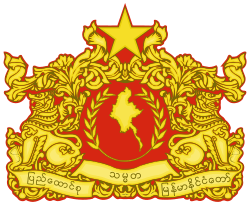
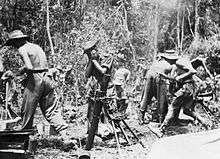
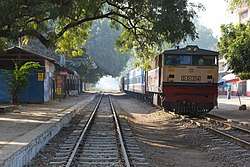
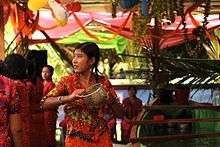
.svg.png)